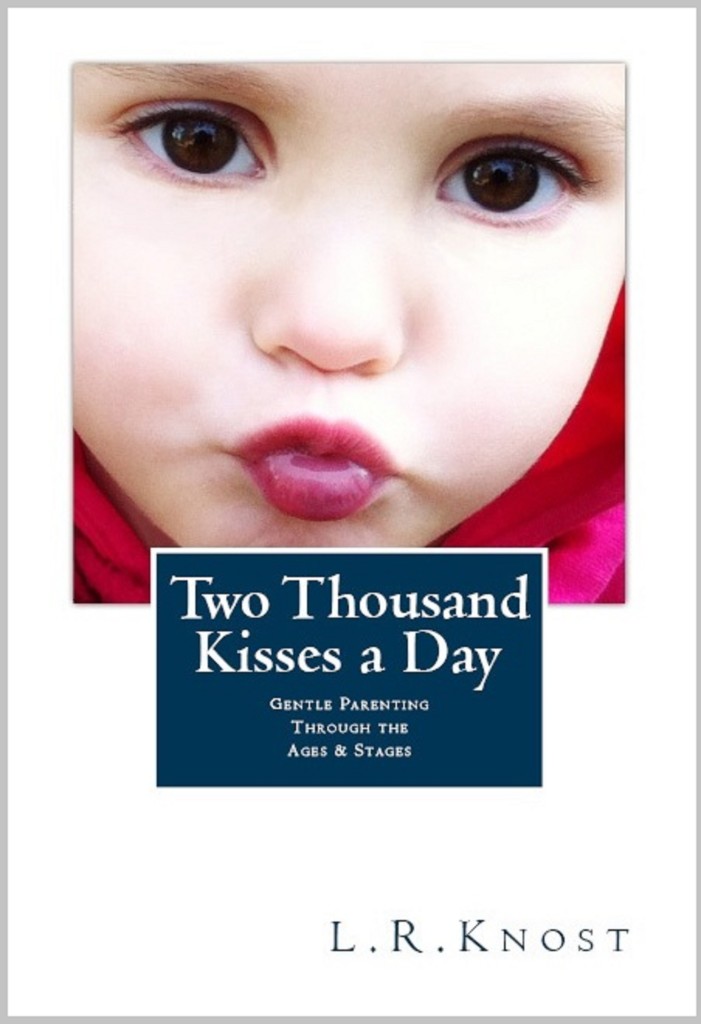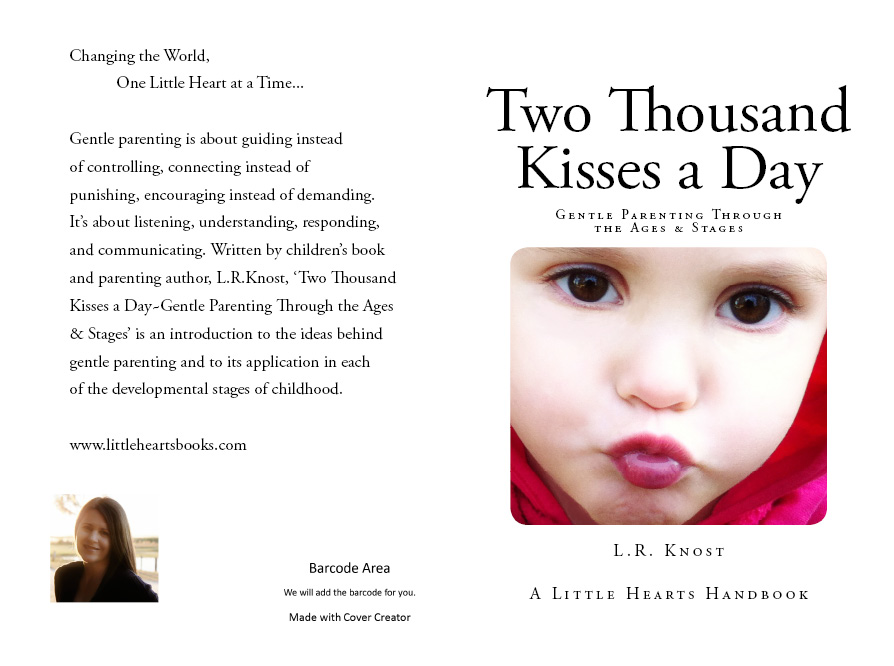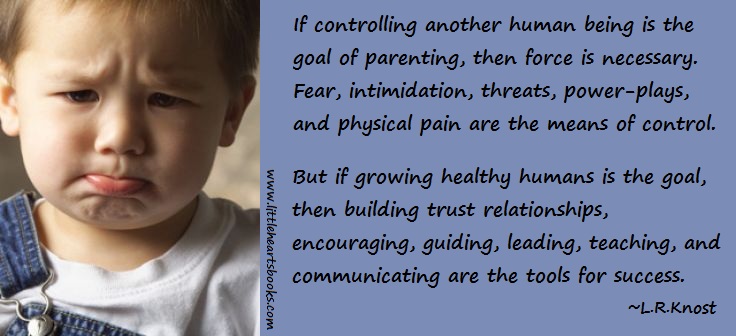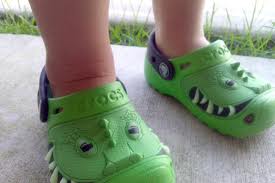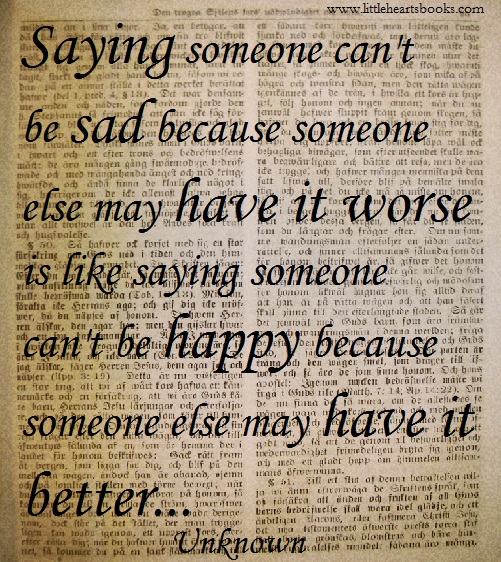Bridge Over Troubled Waters~Parenting a ‘Problem’ Child
[Portions reprinted from The Gentle Parent: Positive, Practical, Effective Discipline by L.R.Knost. Two Thousand Kisses a Day: Gentle Parenting Through the Ages and Stages and Whispers Through Time: Communication Through the Ages and Stages of Childhood also available on Amazon and through other major retailers.]

We all have times when we struggle, when life gets hard, when stresses overtake us and the constant demands to grow and change and learn inherent in simply being human just feel like too much to bear.
Children are no different than adults in that they, too, can often feel overwhelmed by life. The sheer volume of growth and change and learning integral to childhood inevitably produce stress, though that isn’t necessarily a negative for all children. Some children, just like some adults, seem to have an innate ability to cope with stress, to adapt to change, and to face and conquer challenges. Some personalities even thrive on it!
But then there are those children who simply seem to struggle with life. Growth spurts cause incredible stress and discomfort. Change produces intense anxiety and resistance. And learning, being introduced to new thoughts and ideas, being stretched and challenged, inspires unease and distress.
These children are often labeled problem children, strong-willed, difficult, entitled, or brats. The reality, though, is that these are often the most sensitive children, small people who were created to be intimately in-tune with their bodies, their environment, and their fellow human beings. They feel, deeply and empathetically, other people’s pain and distress. They endure shifts in their surroundings like frontal assaults to their safety and security. They experience touch and movement of their bodies, and growth within their bodies, with painful intensity.
All too often, these sensationally gifted children are misunderstood. Their strong reactions to stimuli are misinterpreted as willfulness and stubbornness. They are punished instead of helped, controlled instead of supported, hurt instead of heard. Their uniqueness, gifts, and insights are forced underground where they often simmer in silence, bursting forth in flashes of rage or turning inward in brooding depression.
These children don’t need labels. They don’t need to be contained or controlled. They need what all children need…love, understanding, and guidance to grow into the gifted, unique individuals they were created to be.
Helping and supporting your sensitive child who is struggling is like building a bridge over troubled waters using the Three C’s of gentle discipline:
Connect:
- Observe and really get to know, understand, and appreciate the gifts and needs of the unique little person you are privileged to parent.
- Build a foundation of trust and respect in your parent/child relationship by ‘listening’ to the needs being expressed by your child’s behavior even when their behavior seems completely out of proportion to the situation.
Communicate:
- Keep an open door policy, particularly in the late evening hours when the house is quiet and everyone else is settled for the night. Sensitive children often need stillness to feel safe enough to begin processing all of the overwhelming stimuli and emotions they experience throughout the day.
- Help them to verbalize their feelings and experiences by listening to their hearts and not just their words, and quietly offering observations to help them to put things into perspective.
Cooperate:
- Work with your sensitive child to help them find coping mechanisms that will help them deal with overwhelming sensations, emotions, and situations. Some ideas are to offer them options such as…
- wearing noise-cancelling headphones to block out extraneous noises
- escaping to a Cozy Cave to take a break from the stresses of daily life
- creating a private code word that they can use to let you know they are feeling overwhelmed or that you can use to alert them that they may need to take a break or to dial things down a notch or two
- Equip them with tools to express themselves in acceptable ways (i.e. “It’s not okay to be rude, but it is okay to tell someone you need a break” or “It’s not okay to run away at school, but it is okay to go to your teacher and tell them you’re having a hard time.”)
- Work with them intentionally on a daily basis to overcome the stresses and minimize the impacts of what is, to us, normal daily life, but to them can be deeply troubling experiences.
Building a strong, supportive bridge into the future with your sensitive child will provide them with the coping skills they’ll need as adults to overcome normal stresses and challenges as well as those that come when life inevitably flows into troubled and turbulent waters.
For more tips for parenting your sensitive child and helping them learn coping mechanisms to deal with stresses, see The Gentle Parent: Positive, Practical, Effective Discipline.
Related posts:
Backtalk is Communication…LISTEN
The Gift of a Strong-Willed Child
When Children Act Out ~ Reflecting Our Emotions
The Incredible Power of the Whisper
The Taming of the Tantrum: A Toddler’s Perspective
The Thoughtful Parent’s Guide to Positive Parenting Guides
Simon and Garfunkel – Bridge Over Troubled Water Studio Version
When you’re weary, feeling small
When tears are in your eyes
I will dry them allI’m on your side
When times get rough
And friends just can’t be foundLike a bridge over troubled water
I will lay me down
Like a bridge over troubled water
I will lay me downWhen you’re down and out
When you’re on the street
When evening falls so hard,
I will comfort youI’ll take your part
When darkness comes
And pain is all aroundLike a bridge over troubled water
I will lay me down
Like a bridge over troubled water
I will lay me downOh, if you need a friend
I’m sailing right behindLike a bridge over troubled water
I will ease your mind
Like a bridge over troubled water
I will ease your mind…
 Award-winnning author, L.R.Knost, is the founder and director of the children's rights advocacy and family consulting group, Little Hearts/Gentle Parenting Resources, and Editor-in-Chief of Holistic Parenting Magazine. Books by L.R.Knost include Whispers Through Time: Communication Through the Ages and Stages of Childhood ; Two Thousand Kisses a Day: Gentle Parenting Through the Ages and Stages ; The Gentle Parent: Positive, Practical, Effective Discipline ; and Jesus, the Gentle Parent: Gentle Christian Parenting the first four books in the Little Hearts Handbook gentle parenting series, and children’s picture books Petey’s Listening Ears and the soon-to-be-released Grumpykins series.
Award-winnning author, L.R.Knost, is the founder and director of the children's rights advocacy and family consulting group, Little Hearts/Gentle Parenting Resources, and Editor-in-Chief of Holistic Parenting Magazine. Books by L.R.Knost include Whispers Through Time: Communication Through the Ages and Stages of Childhood ; Two Thousand Kisses a Day: Gentle Parenting Through the Ages and Stages ; The Gentle Parent: Positive, Practical, Effective Discipline ; and Jesus, the Gentle Parent: Gentle Christian Parenting the first four books in the Little Hearts Handbook gentle parenting series, and children’s picture books Petey’s Listening Ears and the soon-to-be-released Grumpykins series.
All the ‘Right’ Parenting Moves
[Portions reprinted from The Gentle Parent: Positive, Practical, Effective Discipline by L.R.Knost. Whispers Through Time: Communication Through the Ages and Stages of Childhood and Two Thousand Kisses a Day: Gentle Parenting Through the Ages and Stages also available on Amazon and through other major retailers.]
~~~~~~~~~~~~~~~~~~~~~
“Gentle Parenting doesn’t cure childhood because childhood isn’t a disease. It doesn’t fix children because children aren’t broken. Time is the only cure, the only fix. Time passes. Childhood ends. Gentle parenting simply recognizes normal childhood behavior as normal and guides children through the normal ages and stages of childhood with compassion and respect.”
~L.R.Knost
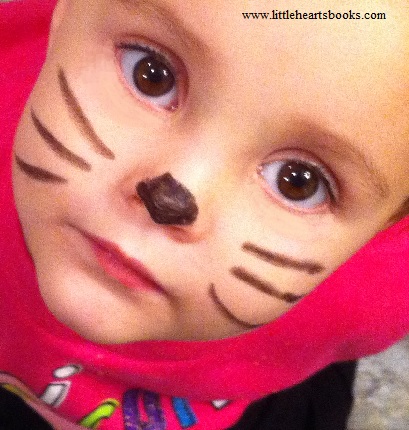 Ever have one of those days where you make all the ‘right’ parenting moves, but your children still act like children? (Do I hear a resounding “YES!!!” bouncing off the walls of cyberspace? Lol.) Of course we all have, and a whole lot more than just one day, too!
Ever have one of those days where you make all the ‘right’ parenting moves, but your children still act like children? (Do I hear a resounding “YES!!!” bouncing off the walls of cyberspace? Lol.) Of course we all have, and a whole lot more than just one day, too!
I’m still chuckling over the comment someone left me that said something along the lines of me clearly never having had a ‘problem child’ and wishing me good luck if I ever have more than one child because then my chances of having said ‘problem child’ would increase. For the record, amongst my six children I have two with sensory issues, one with full-blown Sensory Processing Disorder, two with ADD, one with Auditory Processing Disorder, and two who would be labeled ‘strong-willed’ or ‘high-maintenance’ or even ‘problem children’ by people who want to label children.
 The thing that people so often misunderstand, though, is that gentle parenting is not about stopping our children from being children. It’s about guiding our children through childhood with gentleness, compassion, and respect. It’s about viewing normal childhood behavior as normal, and working with our children in developmentally appropriate ways to teach and inspire and encourage them to become the extraordinary people they were created to be.
The thing that people so often misunderstand, though, is that gentle parenting is not about stopping our children from being children. It’s about guiding our children through childhood with gentleness, compassion, and respect. It’s about viewing normal childhood behavior as normal, and working with our children in developmentally appropriate ways to teach and inspire and encourage them to become the extraordinary people they were created to be.
So, when my extraordinary little people act like children and I make all the ‘right’ parenting moves and yet it still turns out to be a frustrating, tiring, out-of-sorts kind of day for all of us, that’s perfectly okay with me. We all have days like that. We start over again the next day…and the day after that…and the day after that. That’s just how crazy, beautiful, wonderful life with children goes. ♥
For more gentle parenting resources, check out:
The Gift of a Strong-Willed Child
Bridge Over Troubled Waters~Parenting a ‘Problem’ Child
Backtalk is Communication…LISTEN
The Taming of the Tantrum: A Toddler’s Perspective
Practical, Gentle, Effective Discipline
200 Ways to Bless Your Children with a Happy Childhood
The Thoughtful Parent’s Guide to Positive Parenting Guides
When Children Hit~10 Tips for Parents
Testing the Boundaries~What’s a Parent to Do?
Toddlers, Tantrums, and Time-Ins, Oh My!
 Award-winnning author, L.R.Knost, is the founder and director of the children's rights advocacy and family consulting group, Little Hearts/Gentle Parenting Resources, and Editor-in-Chief of Holistic Parenting Magazine. Books by L.R.Knost include Whispers Through Time: Communication Through the Ages and Stages of Childhood ; Two Thousand Kisses a Day: Gentle Parenting Through the Ages and Stages ; The Gentle Parent: Positive, Practical, Effective Discipline ; and Jesus, the Gentle Parent: Gentle Christian Parenting the first four books in the Little Hearts Handbook gentle parenting series, and children’s picture books Petey’s Listening Ears and the soon-to-be-released Grumpykins series.
Award-winnning author, L.R.Knost, is the founder and director of the children's rights advocacy and family consulting group, Little Hearts/Gentle Parenting Resources, and Editor-in-Chief of Holistic Parenting Magazine. Books by L.R.Knost include Whispers Through Time: Communication Through the Ages and Stages of Childhood ; Two Thousand Kisses a Day: Gentle Parenting Through the Ages and Stages ; The Gentle Parent: Positive, Practical, Effective Discipline ; and Jesus, the Gentle Parent: Gentle Christian Parenting the first four books in the Little Hearts Handbook gentle parenting series, and children’s picture books Petey’s Listening Ears and the soon-to-be-released Grumpykins series.
Why Whining is a Win!
[Reprinted from Whispers Through Time: Communication Through the Ages and Stages of Childhood by L.R.Knost. Two Thousand Kisses a Day: Gentle Parenting Through the Ages and Stages and The Gentle Parent: Positive, Practical, Effective Discipline also available through Amazon and other major retailers.]
 It’s seven o’clock and you’re finishing up the dishes before starting bedtime baths. And then it starts…the whining. Every. Single. Night. Your four-year-old knows the routine. She knows you are going to read her favorite bedtime book. She knows you will let her choose which pajamas to wear. She knows she has to brush her teeth. But that doesn’t stop her from standing in the kitchen night after night whining about the same things.
It’s seven o’clock and you’re finishing up the dishes before starting bedtime baths. And then it starts…the whining. Every. Single. Night. Your four-year-old knows the routine. She knows you are going to read her favorite bedtime book. She knows you will let her choose which pajamas to wear. She knows she has to brush her teeth. But that doesn’t stop her from standing in the kitchen night after night whining about the same things.
So what’s the deal? Short-term memory loss? An innate desire to drive you crazy? A disorder of the vocal cords that makes using a normal voice impossible after the sun sets and every time she doesn’t get her way all day long?!?
Here’s a shocker for you: Whining is actually a sign of maturity! Yep, that unnerving, endless, nails-on-a-chalkboard, make-your-head-explode whine is a sign that your little one is growing up and, get this, gaining self-control! I can see your heads shaking, but read on, parents, caregivers, and bleeding ears of the world, read on.
Whining, believe it or not, is an advanced skill. Babies come into the world with exactly one form of verbal communication–crying. They may smack their lips and root for the breast when hungry. They may arch their back or wiggle in discomfort when they need a diaper change. But when physical expressions don’t result in needs being met or their needs are emotional rather than physical, then crying is always the ‘default’ communication. Every need, every discomfort, every bit of loneliness or anxiety or frustration or stress has to be communicated through that one single venue.
Over time as babies grow into toddlers, they begin to learn new ways to communicate, pointing, grunting, picking up a few words here and there, and they move into a more interactive stage wherein they make attempts to communicate in these new ways, but fall back very quickly into crying if they aren’t understood and responded to quickly.
As time goes on, toddlerhood gives way to the preschool years and language skills advance, becoming the main source of communication for a little one. But even so, their grasp of language is limited and their prefrontal cortexes (center of forethought/pre-thinking skills) are still developing. This leads to a rather dichotomous situation in which they know what they want to say, but often can’t quite put the words together quickly or clearly enough for us oh-so-impatient adults.
As they work to communicate, their frustration levels rise and stress hormones sap the blood flow from those underdeveloped ‘thinking’ portions of their brains and, just when they need the use of language the most, they begin to lose the ability to articulate their needs. As toddlers they would fall quickly back into crying at this point, but as preschoolers their more advanced self-control helps them to avoid immediately dissolving into tears and, instead, they fall into the ‘middle-ground’ of whining.
Whining is, in fact, just an advanced form of crying and, as such, is just as grating on the nerves as crying because it is designed to get the attention of a caregiver. The difference is actually in our attitudes toward whining. We accept crying as a normal part of baby and toddlerhood, but label the whining of a preschooler ‘bratty’ and ‘spoiled’ and refuse to listen to them until they ‘use their normal voice’ just when they need us to listen the most!
If we, as adults, would adjust our mindsets to accept the normalcy of whining, it would lose a bit of its power to annoy while enabling us to respond empathetically to our children when they’re mustering all their newly-developed coping skills to avoid a meltdown.
So, what can we do when our little ones lapse into ‘whine-eze’ and we feel like tearing our hair out? Well, as always, an ounce of prevention is worth a pound of cure:
- Pay attention to the time of day whining seems to occur most often.
- Watch for triggers such as hunger, missed naps, and over-hurried schedules.
- Make whatever adjustments you can to prevent the whining before it starts.
- If all else fails and the whining does commence, remember that your little one is struggling to communicate in that moment. Respond by slowing down, sitting with them or kneeling down in front of them, and giving them your full attention.
- Use a quiet, soothing tone to reassure them, and listen patiently all the way through as they work their way back through the frustration and find the words to express themselves.
- You may not be able to give them the toy or snack or whatever else it is they want at that moment, but giving them the chance to be heard is often enough to forestall an all-out meltdown.
More than anything, though, giving your little ones the gift of your time and attention when they need it most (and often seem to deserve it least) will help foster that all-important connection that provides the basis for gentle guidance and boundary-setting. And, as an added bonus, children who feel heard tend to outgrow the whining stage much earlier than children who feel like they have to fight to be heard.
Related posts:
The Gift of a Strong-Willed Child
Backtalk is Communication…LISTEN
When Children Act Out ~ Reflecting Our Emotions
Bridge Over Troubled Waters~Parenting a ‘Problem’ Child
The Taming of the Tantrum: A Toddler’s Perspective
Practical, Gentle, Effective Discipline
200 Ways to Bless Your Children with a Happy Childhood
When Children Hit~10 Tips for Parents
Toddlers, Tantrums, and Time-Ins, Oh My!
 Award-winnning author, L.R.Knost, is the founder and director of the children's rights advocacy and family consulting group, Little Hearts/Gentle Parenting Resources, and Editor-in-Chief of Holistic Parenting Magazine. Books by L.R.Knost include Whispers Through Time: Communication Through the Ages and Stages of Childhood ; Two Thousand Kisses a Day: Gentle Parenting Through the Ages and Stages ; The Gentle Parent: Positive, Practical, Effective Discipline ; and Jesus, the Gentle Parent: Gentle Christian Parenting the first four books in the Little Hearts Handbook gentle parenting series, and children’s picture books Petey’s Listening Ears and the soon-to-be-released Grumpykins series.
Award-winnning author, L.R.Knost, is the founder and director of the children's rights advocacy and family consulting group, Little Hearts/Gentle Parenting Resources, and Editor-in-Chief of Holistic Parenting Magazine. Books by L.R.Knost include Whispers Through Time: Communication Through the Ages and Stages of Childhood ; Two Thousand Kisses a Day: Gentle Parenting Through the Ages and Stages ; The Gentle Parent: Positive, Practical, Effective Discipline ; and Jesus, the Gentle Parent: Gentle Christian Parenting the first four books in the Little Hearts Handbook gentle parenting series, and children’s picture books Petey’s Listening Ears and the soon-to-be-released Grumpykins series.
Backtalk is Communication…LISTEN
[Reprinted from Whispers Through Time: Communication Through the Ages and Stages of Childhood by L.R.Knost. Two Thousand Kisses a Day: Gentle Parenting Through the Ages and Stages and The Gentle Parent: Positive, Practical, Effective Discipline also available through Amazon and other major retailers.]
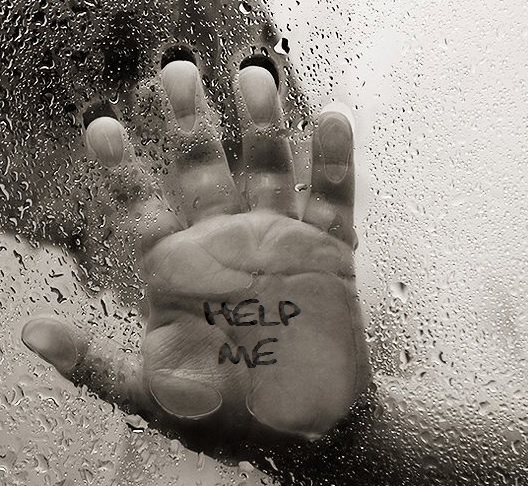 With more than 90% of parents admitting to spanking or otherwise physically punishing their children at least occasionally, mainstream American parenting can certainly be defined as punitive. If you go to the library or browse the shelves at Barnes & Noble or check out Amazon’s best sellers in the parenting genre, you will find a predominance of popular, punishment-based, obedience-focused parenting guides. Whether its spanking or time outs or removal of privileges or time confined in their room, the vast majority of children in the United States are raised with punitive parenting.
With more than 90% of parents admitting to spanking or otherwise physically punishing their children at least occasionally, mainstream American parenting can certainly be defined as punitive. If you go to the library or browse the shelves at Barnes & Noble or check out Amazon’s best sellers in the parenting genre, you will find a predominance of popular, punishment-based, obedience-focused parenting guides. Whether its spanking or time outs or removal of privileges or time confined in their room, the vast majority of children in the United States are raised with punitive parenting.
When it comes to children talking back to parents, many of these punitive parenting guides dictate a zero-tolerance policy. By their definition, backtalk is often characterized as verbal or emotional abuse of parents, defiance, rudeness, or threats:
- Verbal or emotional abuse of parents is considered any statement that insults or hurts a parent such as, “You’re so mean!” or “I wish I didn’t even have parents!” or “I hate you!”
- Defiance is any statement containing the word “No” in response to a parental command.
- Rudeness is defined as anything from deep sighs to rolled eyes to stomped feet.
- Threats are any statements that give conditions such as, “If you take away my cell phone, I’ll just go get a new one!” or “If you don’t drive me to my friend’s house, I’m walking there!”
These parenting guides direct parents to decide which punishment to mete out when their child talks back to them, specifying that the deciding factor should be whichever punishment would be the most unpleasant, painful, and distressing for the child. Punishments are to be carried out swiftly and without discussion. When the retribution for the child’s actions is over, it is to be followed with a lecture laying down the laws of the family. Again, no discussion is allowed, but if the child expresses appropriate penitence, love and hugs can then be offered.
In addition to the sick feeling in the pit of my stomach at the thought of children being subjected to this kind of harsh, punitive parenting, I’m saddened by the upside-down reasoning that shuts communication down instead of utilizing it to bring healing, understanding, and restoration to the parent/child relationship.
Take a look at the order of parenting prescribed: First, punishment meted out by the parent. Second, lecture delivered by the parent. Third, conditional reconnection based on a proper expression of remorse to the parent from the child.
In gentle parenting, the order and intent of parenting would be the polar opposite: First would come listening for the need behind the behavior and reconnecting with the child at the point of need. Second, would be initiating a two-way communication about the problem and brainstorming about how to address the issue in ways that will meet everyone’s needs. Third, would be offering guidance and equipping the child with better ways to express needs in the future.
The punitive parenting approach focuses on the child as the problem and attempts to solve the problem by ‘fixing’ the child through intentionally unpleasant external forces.
The gentle parenting approach focuses on the child having a problem and attempts to help the child solve the problem through connection, communication, and inviting cooperation.
Now look at the definitions of backtalk–verbal and emotional abuse of parents, defiance, rudeness, and threats. The questions that immediately arise are: What about the parents? Are they held to the same standards as the children? Or do they threaten? Do they say ‘No’? Do they sigh? Do they hurt their children?
As parents, our actions will always be reflected in our children’s behavior. Children learn what they live. No amount of lecturing can undo the powerful impact on a child of their parent’s own behavior and choices.
When a child backtalks, sometimes also referred to as mouthing-off or sassing, they are in the throes of a huge, internal maelstrom of emotion. Whatever they are reacting to in the moment, whether it’s being told ‘no’ about something or being asked to do or not do something, it is rarely those issues that are at the root of the problem. The moment at hand is just the tipping point causing a fissure in the child’s heart that lets out a bit of the steam inside. The real concern should be that there is, metaphorically, steam in the child’s heart to begin with.
It is at this point that parents have the opportunity to model self-control and self-regulation by controlling their own knee-jerk reaction to their child’s backtalk. Instead of meeting fire with fire, childish outburst with childish parental outburst, child’s tantrum with adult tantrum, parents can slow down, breathe through their own emotions, and then listen through the fiery storm of their child’s words to the hurt, fear, and anger behind the words.
In the same way that “a gentle answer turns away wrath,” a soft-voiced, “Let’s take a minute and calm down so we can work through this together, okay?” from a parent is a magical, healing balm that immediately begins to diffuse tough situations and creates an atmosphere in which connection and communication can bring effective, peaceful solutions not only to the issue at hand, but to the inner turmoil that prompted the outburst in the first place.
Meeting a child at their point of need when that need is expressed through meltdowns, yelling, disrespect, or defiance takes patience, self-control, and empathy on the part of a parent, which can be a huge growth experience for the parent if they, themselves, were not parented that way. But the impact of living those positive life skills in front of our children is immeasurable.
Parenting isn’t a perfect science and parents aren’t perfect people, but creating an overall atmosphere of respect in a home starts with the parents modeling respect in their own tone of voice, in their own reactions to stressful situations, in their own interactions with their children.
It’s not easy, for sure. But the best things, the most valuable things, in life rarely are. Working toward being understanding, available, and responsive to our children’s needs yields a priceless return in our relationship as the years fly by and adulthood looms. Not meeting those needs, though, may have serious negative consequences…
Dear Daughter,
You entered your teen years with a bang a few years ago, and the explosions have been shattering our home ever since. I’ve begged, threatened, bribed, and punished; cried, shouted, and bargained; but I just can’t find a way to reach you anymore. You constantly say I don’t listen to you, but how can I when you won’t talk to me? You say I don’t understand you, but how can I when you push me away? You say we aren’t a family, but then spend every day with earphones in your ears, blocking us out. You ask me why I hate you, then roll your eyes when I tell you I love you. How did it come to this? We used to be such a happy family. Please, let me be there for you during this huge transition in your life. Let’s really try to communicate with each other. I’m just lost here, honey, and I need you to reach out and help me reconnect with you. I love you.
Your Dad
‘Dear’ Dad,
Happy family? Are you kidding me? No, I guess not. You never did get it. Okay, you asked, so I’ll tell you. You were always happy because you were always in control. Want to know why I don’t talk to you now? Because you never listened when I was little. When I was scared in my room at night and called you, you either ignored me or threatened to spank me if I didn’t go to sleep. I’d lay there, crying so hard I’d almost throw up, terrified of the sounds and shadows in my room, but even more terrified of you. So, sorry, but I don’t buy that you’re ‘there for me’ when it’s only ever been at your own convenience. When you were mad at something I’d done and I tried to explain myself, you’d call it backtalk and smack me in the mouth. So forgive me if I don’t really believe you when you say you want to ‘communicate’ with me now. When I’d try to show you a dance I’d made up or tell you about how someone had pushed me on the playground, you couldn’t even be bothered to look away from your stupid computer while I was talking, so if I’m wrapped up in my electronics, I learned that little trick from you, Father Dear. Oh, and reconnect? Really? That implies that we were once connected. But when I was a little girl and invited you into my world and asked you to play with me, you were always too busy. So if you don’t understand me, sorry, but that invitation expired years ago. Want to know why I think you hate me? Because your actions told me so. Your ‘love’ is just words.
‘Your’ Daughter
Not all children react this way to harsh, punitive, control-based parenting, of course. Some children, due to personality, other influences and mentors in their lives, or simply as a survival instinct, will turn out okay despite how they are parented.
But ‘okay’ is too mediocre a goal when it comes to growing our children into the adults who will one day lead our world. Instead of raising children who turn out okay despite their childhood, let’s raise children who turn out extraordinary because of their childhood. Let’s grow excellent, outstanding, remarkable adults who will be world changers for the next generation and the generations to come.
Related posts:
When Children Act Out ~ Reflecting Our Emotions
Changing the World, One Little Heart at a Time
Practical, Gentle, Effective Discipline
 Award-winnning author, L.R.Knost, is the founder and director of the children's rights advocacy and family consulting group, Little Hearts/Gentle Parenting Resources, and Editor-in-Chief of Holistic Parenting Magazine. Books by L.R.Knost include Whispers Through Time: Communication Through the Ages and Stages of Childhood ; Two Thousand Kisses a Day: Gentle Parenting Through the Ages and Stages ; The Gentle Parent: Positive, Practical, Effective Discipline ; and Jesus, the Gentle Parent: Gentle Christian Parenting the first four books in the Little Hearts Handbook gentle parenting series, and children’s picture books Petey’s Listening Ears and the soon-to-be-released Grumpykins series.
Award-winnning author, L.R.Knost, is the founder and director of the children's rights advocacy and family consulting group, Little Hearts/Gentle Parenting Resources, and Editor-in-Chief of Holistic Parenting Magazine. Books by L.R.Knost include Whispers Through Time: Communication Through the Ages and Stages of Childhood ; Two Thousand Kisses a Day: Gentle Parenting Through the Ages and Stages ; The Gentle Parent: Positive, Practical, Effective Discipline ; and Jesus, the Gentle Parent: Gentle Christian Parenting the first four books in the Little Hearts Handbook gentle parenting series, and children’s picture books Petey’s Listening Ears and the soon-to-be-released Grumpykins series.
The Incredible Power of the Whisper

[Reprinted from Whispers Through Time: Communication Through the Ages and Stages of Childhood by L.R.Knost. Two Thousand Kisses a Day: Gentle Parenting Through the Ages and Stages and The Gentle Parent: Positive, Practical, Effective Discipline also available on Amazon and through other major retailers.]
If a picture is worth a thousand words, then a whisper is worth two thousand when it comes to parenting. In the same way that the instinctive human reaction to someone raising their voice is to raise our voice one octave higher, to out-shout the shouter, to over-power the person powering-up on us, the instinctive human response to someone whispering is to quiet down, to lean-in, to listen.
As parents, it’s up to us to exercise the wisdom and maturity to control our own instinctive reaction to our children’s piercing screams, ear-shattering shrieks, and mind-blowing, foot-stomping, out-of-control fits. Small people have big emotions and need help processing them. Their cries as babies and shrieks and tantrums as toddlers and meltdowns as preschoolers are, literally, cries for help.
Ignoring or punishing them, or reacting with anger ourselves, simply forces them to bury their unresolved emotions and causes us to miss an opportunity to not only share our wisdom by helping them process their big feelings, but also to guide our children toward more appropriate ways to communicate as they grow. In some cases, when a child’s emotions are forced underground it results in a child who simmers with hidden rage just waiting to explode again or, worse, the rage may turn inward and result in a child who is withdrawn, detached, or even depressed.
Having parenting tools ready and waiting for the inevitable challenges of raising little humans is wise. When emotions begin running high, and as parents we can feel our own stress levels rising, knowing we have a well-stocked parenting toolbox with tried and tested tools helps us to keep our cool so that we can parent more intentionally and effectively.
In the first weeks of life, a baby has one ‘default’ mode of verbal communication…crying. They may give physical cues to their needs such as chewing on their hands to indicate hunger or the beginning of teething, but their verbal communication takes the sole form of crying.
From those first tiny squeaks and mewls of a newborn, a baby’s cries mature into whimpers, squeals, screams, and sobs, all communicating one thing: “I need help.” When we respond to our baby’s cries quickly and gently, whether it’s to feed them or change them or give them a cuddle, we communicate in return, “I’m here. You can count on me.”
But then there are those times when we’ve fed them, changed them, burped them, rocked and cuddled and walked with them, and their piercing screams still shatter the silence…and our hearts. Those are times when parents often begin to feel overwhelmed, stressed, sometimes even resentful and angry because no matter what they try, they can’t ‘fix’ their baby and make them stop crying. It is in those moments of frustration and distress that we need to breathe in deeply to calm ourselves, then stop stressing over trying to ‘fix’ our baby and instead whisper in our little one’s ear, “I’m here. I’ve got you. We’ll get through this together.” They may not understand our words, but they will hear our heart.
The truth is that a baby’s cries can’t always be ‘fixed’ and sometimes the need they’re communicating is the need to express their emotions, but they always, always need the comfort and assurance that they will be heard and that their needs will be met and that they can trust us to be there for them, no matter what.
Once a baby reaches the crawling, exploring, discovering stage, they often have a great time experimenting with the volume, pitch, and range of their voice, much to the chagrin of their parents and pretty much everyone else within earshot. The ear-shattering squeals and bellows and joyful shrieks at this stage can be disconcerting to us parents, to say the least, especially when our little falsetto performs their operatic interpretation in public places such as doctor’s offices, libraries, and restaurants.
This is a prime opportunity to exercise the power of the whisper. When the first shriek splits the silence, we can hold our finger to our lips, smile like we’re inviting them to join in on a secret, and whisper, “It’s whisper time. Let’s use our little voices together.” Making a game out of it invites cooperation rather than demands obedience, a much more effective parenting technique, and practicing little voices together demonstrates what we want our little one to do instead of simply telling them what we don’t want them to do.
Don’t be surprised if it takes many repetitions over several outings before your little one begins to get the idea, though. As with all parenting, time and patience and an awareness (and acceptance!) of what is normal for each developmental stage is key.
Toddlers and preschoolers are famous for their big tantrums sparked by big emotions and big frustrations. Obviously being aware of and avoiding tantrum triggers such as hunger, tiredness, and over-stimulation is important. But even with the most proactive parenting, there may still be times when our little ones have unexpected, incomprehensible, inconsolable tantrums.
When faced with a toddler or preschooler in the throes of a tantrum, if we know what caused the tantrum, we can validate the emotion with a soft-voiced, “You’re angry (disappointed, sad, hurt) because you (fill in the blank).” Often just hearing their feelings put into words is enough to calm a toddler who is frustrated at their inability to express themselves, but sometimes they need a bit of time and support to work through their big emotions.
If the tantrum continues we need to stay calm and present and remember that we are modeling self-control and self-regulation when we practice those skills instead of having an adult-style tantrum in response to our child’s tantrum. Instead of trying to control our child’s outburst with demands or threats or bribes, we can simply stay close and whisper, “I hear you. I’m here.”
The secret of the whisper in taming a tantrum can be seen in the difference between dumping a bucket of water on a fire, which can force the fire underground where it may smolder and reignite unexpectedly, versus spraying a gentle mist on the fire so it’s slowly and fully extinguished, leaving the ground saturated so the fire won’t reignite. Settling your little one quietly and patiently with a whisper is the gentle mist that saturates them with your unconditional love and support so they don’t simmer with hidden rage that may erupt spontaneously again.
Remember, no matter the problem, kindness is always the right response. When your child is having a problem, stop, listen, then respond to the need, not the behavior. The behavior can be addressed later, after the need has been met, because only then is the door to effective communication truly open.
The thing to keep in mind is that there is no cure for childhood. There is no parenting secret that will ‘work’ to keep children from being children. Children will cry. They will tantrum. They will yell and giggle and climb and run and throw things and build things and hit and hug and explore and make glorious mistakes and incredible discoveries. They will be human. They will be children. And that’s more than okay. That’s beautiful, messy, wonderful childhood, just as it should be.
Parents are guides through the incredible journey of childhood, not to keep their children from experiencing childhood, but to keep them safe as they learn the magnificent life lessons that childhood has to offer.
Related posts:
The Taming of the Tantrum: A Toddler’s Perspective
Practical, Gentle, Effective Discipline
10 Ways to Play with your Children when Play is the Last Thing on your Mind
200 Ways to Bless Your Children with a Happy Childhood
Playground Confessions~Look Who’s Talking!
When Children Hit~10 Tips for Parents
Testing the Boundaries~What’s a Parent to Do?
Toddlers, Tantrums, and Time-Ins, Oh My!
Easy Peasy DIY Parenting Tools
 Award-winnning author, L.R.Knost, is the founder and director of the children's rights advocacy and family consulting group, Little Hearts/Gentle Parenting Resources, and Editor-in-Chief of Holistic Parenting Magazine. Books by L.R.Knost include Whispers Through Time: Communication Through the Ages and Stages of Childhood ; Two Thousand Kisses a Day: Gentle Parenting Through the Ages and Stages ; The Gentle Parent: Positive, Practical, Effective Discipline ; and Jesus, the Gentle Parent: Gentle Christian Parenting the first four books in the Little Hearts Handbook gentle parenting series, and children’s picture books Petey’s Listening Ears and the soon-to-be-released Grumpykins series.
Award-winnning author, L.R.Knost, is the founder and director of the children's rights advocacy and family consulting group, Little Hearts/Gentle Parenting Resources, and Editor-in-Chief of Holistic Parenting Magazine. Books by L.R.Knost include Whispers Through Time: Communication Through the Ages and Stages of Childhood ; Two Thousand Kisses a Day: Gentle Parenting Through the Ages and Stages ; The Gentle Parent: Positive, Practical, Effective Discipline ; and Jesus, the Gentle Parent: Gentle Christian Parenting the first four books in the Little Hearts Handbook gentle parenting series, and children’s picture books Petey’s Listening Ears and the soon-to-be-released Grumpykins series.
The ‘NO’ Zone
[Portions reprinted from Whispers Through Time: Communication Through the Ages and Stages of Childhood by L.R.Knost. Two Thousand Kisses a Day: Gentle Parenting Through the Ages and Stages and The Gentle Parent: Positive, Practical, Effective Discipline also available on Amazon and through other major retailers.]
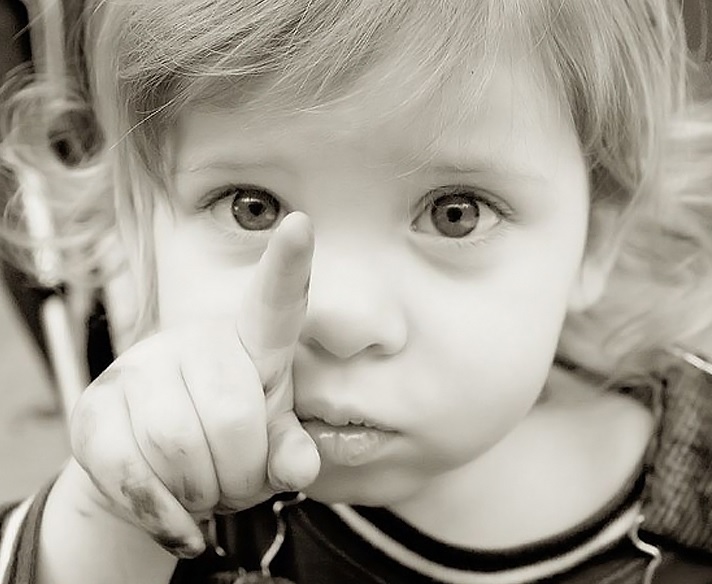 The life of a small child is comprised of a daily onslaught of tempting surfaces begging for the artistry of a crayon, tall places crying out to be scaled, lovely little objects in need of a mouth or nose to visit, and dozens of other alluring glass and liquid and sharp things to be explored through the physics of gravity, the kinetics of concoctions, and the application of Newton’s Laws of Motion. There is only one force powerful enough to defeat this nearly irresistible call of adventure, imagination, and discovery…the No!
The life of a small child is comprised of a daily onslaught of tempting surfaces begging for the artistry of a crayon, tall places crying out to be scaled, lovely little objects in need of a mouth or nose to visit, and dozens of other alluring glass and liquid and sharp things to be explored through the physics of gravity, the kinetics of concoctions, and the application of Newton’s Laws of Motion. There is only one force powerful enough to defeat this nearly irresistible call of adventure, imagination, and discovery…the No!
Every child knows the power of the No to circumvent the most well-laid plans. Even tiny babies just weeks into the world are introduced to its power when they grasp a fistful of hair while nursing or reach for some lovely, squishy stuff while getting a diaper change. That itty bitty two-letter word is packed with a force beyond comprehension to a toddler, and when they finally figure out how to wrap their little lips around those letters and form the word “NO!” themselves, the possibilities seem limitless!
Do you want a cookie? “No!”…Well, actually, yes, but how cool is it that when I said “No!” I controlled whether or not someone gave me a cookie!
Do you want Daddy to hold you? “No!” Well, yes, but I got to decide whether someone held me or not for a change!
Do you want to play outside? “No!” Actually, I do, but do I really get to decide for myself where I go? Cool!
That kind of power and control can go to a little person’s head, for sure! And the change in the big people when the word is used against them clearly demonstrates its incredible value. Their faces go from happy to serious or even angry, and sometimes a little person can even make a big person yell. What dazzling power!
And then when little ones manage a few more words in their vocabulary, they can add direct quotes from the most powerful beings they know ~ mommy and daddy. Quotes like, “I said ‘No’!” and “Don’t you tell me ‘No’!” and “No means ‘No’!”
The authority! The dominion! The clout! And using them against those powerful beings, watching them turn red in the face and yell and threaten…well, it’s a little scary and makes a small person feel really disconnected and upset…but the surge of intense pleasure at feeling powerful and in control almost makes them feel like a big person for a moment!
And that’s what they most long to be, just like mommy and daddy ~ big and strong and smart and powerful.
So what’s a mommy or daddy to do when confronted with the No from their little power-mongers? First, take a deep breath, and then engage those adult brains.
What inherent power is there, really, in a little two-letter word? Only the power we give it! What if, instead of that tiny word being able to push our buttons, we just disconnected the buttons entirely and didn’t react to the No at all? It would simply become a no, just another word to celebrate our precious little people adding to their fledgling vocabularies.
What if we backed up even further and disenfranchised the No from the beginning? When our newborn baby’s flailing hands caught a tiny fistful of hair, what if we just smiled and gently removed it and kissed those itty bitty little fingers?
When our intrepid little explorers discovered the wonders of kitchen cabinets, what if we used cabinet locks but left one or two full of pots and pans and plastic bins for them to discover?
What if when our little people headed for the walls to do their best Michelangelo interpretation on them, we simply intercepted them and offered alternative canvases?
Or what if when they ascended the kitchen cabinets, we just scooped them up and headed outdoors for some climbing adventures?
The thing is, the No is only the No when we, the adults, make it the No. And it can become simply a no when we get creative and interactive and stop using a tiny two-letter word like it has “Phenomenal Cosmic Power in an itty-bitty living space!” (Aladdin 1994)
Related posts:
When Children Act Out ~ Reflecting Our Emotions
7-Year-Old Gentle Parenting Crusader
Changing the World, One Little Heart at a Time
Practical, Gentle, Effective Discipline
 Award-winnning author, L.R.Knost, is the founder and director of the children's rights advocacy and family consulting group, Little Hearts/Gentle Parenting Resources, and Editor-in-Chief of Holistic Parenting Magazine. Books by L.R.Knost include Whispers Through Time: Communication Through the Ages and Stages of Childhood ; Two Thousand Kisses a Day: Gentle Parenting Through the Ages and Stages ; The Gentle Parent: Positive, Practical, Effective Discipline ; and Jesus, the Gentle Parent: Gentle Christian Parenting the first four books in the Little Hearts Handbook gentle parenting series, and children’s picture books Petey’s Listening Ears and the soon-to-be-released Grumpykins series.
Award-winnning author, L.R.Knost, is the founder and director of the children's rights advocacy and family consulting group, Little Hearts/Gentle Parenting Resources, and Editor-in-Chief of Holistic Parenting Magazine. Books by L.R.Knost include Whispers Through Time: Communication Through the Ages and Stages of Childhood ; Two Thousand Kisses a Day: Gentle Parenting Through the Ages and Stages ; The Gentle Parent: Positive, Practical, Effective Discipline ; and Jesus, the Gentle Parent: Gentle Christian Parenting the first four books in the Little Hearts Handbook gentle parenting series, and children’s picture books Petey’s Listening Ears and the soon-to-be-released Grumpykins series.
Whispers Through Time ~ Book Reviews, Author Interviews & Book Trailer
My first book trailer! This was sooooo fun. My children had a blast making it! My toddler decided she was going to join me during my segment, lol, so you’ll see me chatting with her a few times. Nothing wrong with a glimpse of real life, though, right? So, without further ado, here is the official book trailer for Whispers Through Time: Communication Through the Ages and Stages of Childhood. Enjoy!
I’m so honored to have these incredible voices for children reviewing Whispers Through Time: Communication Through the Ages and Stages of Childhood:
Sweet, Funny, Insightful: Whispers Through Time by L.R. Knost is destined to be a dog-eared favorite, passed down from generation to generation. As long as there are children being born into this world and toddlers having tantrums and teens racing toward adulthood at an alarming pace, there will be parents who will turn to this book for guidance. Why? Not because L.R. Knost has all the answers, but because she shows parents how to find their own answers for their own children and their own families. This guidebook challenges conventional thinking with a wisdom born of experience and a healthy dose of research to back it up. Written with the same unique blend of sweetness and humor, grit and honesty, reassurance and insight that made her first book, Two Thousand Kisses a Day, a best-seller, Whispers Through Time is sure to become a runaway hit in its own right. An absolute must-have for any home library. Highly recommended!
Dr. Laura Markham of AhaParenting Audio interview with the author
The Natural Parent Magazine Book trailer and summary
Kidlutions: Solutions for Kids Book review and contest
Parenting Beyond Punishment Book review and giveaway
The Path Less Taken Book review
Mommy Perks Book trailer and review
The Hippie Housewife Book review and giveaway
Diary of a Natural Mom Book review and giveaway
The Mahogany Way Book review and giveaway
Parenting with Understanding Book review and giveaway
Dr. Lynne Kenney: The Family Coach Book Trailer and review
Nurture Parenting Magazine Book trailer and giveaway
Table of Contents:
Chapter 1 ‘Communication: Whispers Through Time’ explores the importance of communication and connection in parent/child relationships.
Chapter 2 ‘Baby Talk’ celebrates those first moments and days and weeks of communication between newborns and parents.
Chapter 3 ‘Becoming Mommy’ shares the beauty of embracing parenthood.
Chapter 4 ‘Baby Signing: A Gentle Introduction to Communication’ introduces the concept of using baby signs to communicate.
Chapter 5 ‘The Power of Perception’ explores the connection between a parent’s perception of their child’s motives and the parent’s response.
Chapter 6 ‘Eleven Tips to Beat the Mama Blues’ shares eleven ways to work through those sometimes hard, sometimes humdrum days of parenthood.
Chapter 7 ‘The Taming of the Tantrum: A Toddler’s Perspective’ explores life from the perspective of a toddler and offers guidance on how to use communication to reduce or eliminate tantrums.
Chapter 8 ‘The NO Zone’ shares ideas for how to respond when a toddler discovers how to use the word, “NO!”
Chapter 9 ‘The Secret of the Whisper’ offers a unique response to little people’s sometimes big emotions.
Chapter 10 ‘Ten Ways to Play When Play is the Last Thing on your Mind’ shares ten ideas for weaving play into an ordinary day
Chapter 11 ‘A Listening Heart’ breaks down the concept of listening and offers ideas for how to pinpoint the issue if listening is a problem.
Chapter 12 ‘A Child’s Heart’ shares a glimpse of the power of communication and connection.
Chapter 13 ‘Why Whining is a Win’ offers a unique perspective on that age-old annoying behavior…whining.
Chapter 14 ‘Can We Talk?’ explores adults’ use of figurative language and the confusion that can result for children.
Chapter 15 ‘Age of Reason: Why, oh Why, Do They Always Ask Why?’ examines why the why stage is so important.
Chapter 16 ‘Five Gentle Tools for Handling Lying’ shares a practical and gentle approach to lying.
Chapter 17 ‘Rethinking Tattling’ explores the importance of listening to tattling.
Chapter 18 ‘The Artist in the Child’ celebrates the differences in children through the unique perspective of the artist.
Chapter 19 ‘Whisper Words of Wisdom’ examines the unseen wounds that thoughtless words can inflict.
Chapter 20 ‘Love Means Sometimes Having to Say You’re Sorry’ shares the importance of making things right when you’ve done something wrong.
Chapter 21 ‘The sWord and the sTone’ covers the importance of living what you want your child to learn.
Chapter 22 ‘Chatterboxes and Dreamers: Is Your Child an Introvert or an Extrovert?’ discusses the different parenting approaches to different personalities.
Chapter 23 ‘I is for `I dunno’ and That’s Good Enough for Me’ shares some insights into the mysteries of the adolescent mind.
Chapter 24 ‘Backtalk is Communication: LISTEN!’ tackles the startling truth that when children talk back they are actually communicating.
Chapter 25 ‘My Huckleberry Friend’ shares the reasons that a parent should not only be their child’s friend, they should be their best friend.
Chapter 26 ‘Whispering Winds of Change’ explores the process of letting them go while still holding them close.
Chapter 27 ‘Messages in a Bottle: Our Hope for the Future’ shares thirty-two messages to write on the hearts and minds of your children before sending them out into the world.
Appendix A ‘Tips for Talking to Teens’
Appendix B ’12 Steps to Gentle Parenting’
Sample chapters:
Backtalk is Communication…LISTEN
The Taming of the Tantrum: A Toddler’s Perspective
10 Ways to Play when Play is the Last Thing on Your Mind
If you’d like to know more about Two Thousand Kisses a Day: Gentle Parenting Through the Ages and Stages or Whispers Through Time: Communication Through the Ages and Stages of Childhood, click the links to read more editorial and reader reviews.
Note: For those outside the US who would like to purchase books by L.R.Knost without Amazon’s high international shipping costs, a limited supply is available directly from the author here.
 Award-winnning author, L.R.Knost, is the founder and director of the children's rights advocacy and family consulting group, Little Hearts/Gentle Parenting Resources, and Editor-in-Chief of Holistic Parenting Magazine. Books by L.R.Knost include Whispers Through Time: Communication Through the Ages and Stages of Childhood ; Two Thousand Kisses a Day: Gentle Parenting Through the Ages and Stages ; The Gentle Parent: Positive, Practical, Effective Discipline ; and Jesus, the Gentle Parent: Gentle Christian Parenting the first four books in the Little Hearts Handbook gentle parenting series, and children’s picture books Petey’s Listening Ears and the soon-to-be-released Grumpykins series.
Award-winnning author, L.R.Knost, is the founder and director of the children's rights advocacy and family consulting group, Little Hearts/Gentle Parenting Resources, and Editor-in-Chief of Holistic Parenting Magazine. Books by L.R.Knost include Whispers Through Time: Communication Through the Ages and Stages of Childhood ; Two Thousand Kisses a Day: Gentle Parenting Through the Ages and Stages ; The Gentle Parent: Positive, Practical, Effective Discipline ; and Jesus, the Gentle Parent: Gentle Christian Parenting the first four books in the Little Hearts Handbook gentle parenting series, and children’s picture books Petey’s Listening Ears and the soon-to-be-released Grumpykins series.
Stepping in When Parents are Out-of-Control
[By L.R.Knost, author of The Gentle Parent: Positive, Practical, Effective Discipline, Whispers Through Time: Communication Through the Ages and Stages of Childhood and Two Thousand Kisses a Day: Gentle Parenting Through the Ages and Stages now available on Amazon and through other major retailers.]
~~~~~~~~~~~~~~~~~~~~~
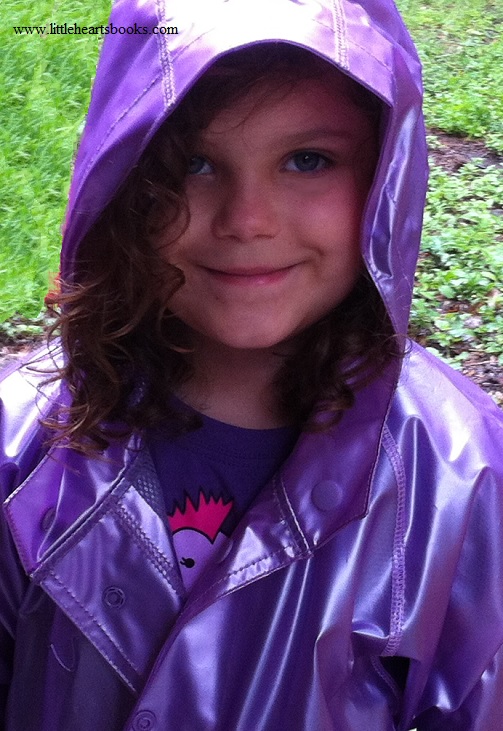 Parents often ask how they can gently and effectively approach a parent who is berating or smacking or otherwise mistreating their child. While the reality is that there is no way to intervene without offending the parent, no matter how kindly it is done, that doesn’t necessarily mean we shouldn’t intervene. Obviously if we believe the child is in danger we should always contact the authorities immediately. Other times, though, there’s no real physical danger, but we can see the parent is out-of-control, is struggling with parenting, or is just too stressed or self-focused to care. What do we do then? Can we intervene in any meaningful, effective way? Should we even try?
Parents often ask how they can gently and effectively approach a parent who is berating or smacking or otherwise mistreating their child. While the reality is that there is no way to intervene without offending the parent, no matter how kindly it is done, that doesn’t necessarily mean we shouldn’t intervene. Obviously if we believe the child is in danger we should always contact the authorities immediately. Other times, though, there’s no real physical danger, but we can see the parent is out-of-control, is struggling with parenting, or is just too stressed or self-focused to care. What do we do then? Can we intervene in any meaningful, effective way? Should we even try?
To answer, let me first me share with you an interesting encounter my seven-year-old little funnyface had recently. She was away from me for four hours in a backstage room with around forty other two- to seven-year-olds for their second ballet recital of the day. A parent volunteer in the room apparently lost her temper with her five-year-old, grabbed her arm, and dragged her across the room with her daughter screaming and fighting to get away, then shoved her in a corner, yelled at her, and pinched her among other things. My seven-year-old related this to me on our way home from her recital and said:
“I saw the mom was having trouble balancing her temper, and I wanted to help her and her poor little girl in the pretty blue ballet dress. The mom cornered the little blue girl and kept yelling and pinching her and flicking her. So I went to her and told her that my mom wrote gentle parenting books and asked if I could have her address so I could ask you to send her one. She didn’t respond to me, but her friend who was there asked for your name, so I told her and she looked it up on her phone and found your books. And then I heard the mad mom tell her friend that she just didn’t know what to do. I said to her that she gets that reaction from her daughter because that’s the reaction she gives to her daughter. I told her that it was like putting a trail of gas all the way to her home because the fire will follow the gas and make the house on fire. Because, you know, anger is like fire. She didn’t talk to me, but her friend did, the one who looked your books up on her phone. I told her that if her friend didn’t know what to do, she just had to listen, because then she would know what to do. Listening is always the first step. And I said to her that kids aren’t just, you know, like things or nothings, we’re people. I wasn’t mean to her, mama. I was very kind when I talked to her even though she didn’t listen to me or talk to me back. I was kind because I wanted her to see how nice kindness felt, then maybe she would want to be kind, too.”
Did the mother suddenly decide to change her parenting? No. But her friend overheard the exchange and wanted to know more. Did the “little blue girl” escape the manhandling and anger of her mother’s adult temper tantrum? No. but she, too, overheard my daughter’s words, and she saw that someone cared. No one can possibly measure the impact a single moment of kindness has on another soul.
And what about my little funnyface? Children learn what they live. They imitate what they see their parents, their most powerful role models, doing. My children have seen me gently intervene on a number of occasions when a parent was out-of-control. They have patiently waited for my attention while I answered a parent’s email or message asking for help with a parenting issue. The older ones have proofread my books, and the younger ones have offered ideas for chapter titles and book covers. They have seen gentle parenting advocacy at work, day in and day out.
Children really do learn what they live. They also walk out what they learn in their own unique way. One of my six, my oldest daughter, went into psychology and became a Family Therapist. She now works with Social Services trying to help families at risk before their children end up in foster care. Another one feels other children’s distress so deeply that we’ve had to leave shops, restaurants, and parks because she gets so upset by ‘normal’ parenting, but she writes her feelings rather than confronting people directly. One day you’ll see her thought-provoking children’s books on store shelves, mark my words. My seven-year-old, as evidenced by the vignette above, is very much like her oldest sister, ready to take on the world in defense of the defenseless.
The value of stepping in when a parent is struggling with their parenting cannot be measured by the parent’s response alone. The parent will most likely be offended and respond negatively, if at all. That momentary break in the parental meltdown, though, does often give the parent a chance to pull themselves together and regain some semblance of control.
But far beyond the value of the moment is the value of a child, helpless in the hands of an angry parent, seeing that someone cares. Of far greater worth than the momentary discomfort of confrontation is the courage and willingness to confront with kindness. And the value goes on and on, in the life of the child, in the hearts of those who overhear and those who hear about it later, and in the life and heart and mind of those courageous enough to meet wrongs head-on and to do so with gentleness.
That value lives on in the beautiful heart and brave spirit of my sweet girl, my little funnyface, my seven-year-old gentle parenting advocate. She is the very definition of my motto, “Changing the World, One Little Heart at a Time.”
If you are confronted with a situation in which a parent or other adult is mistreating a child, don’t hesitate to call authorities if the mistreatment constitutes abuse. But if the adult’s actions wouldn’t be considered abuse by authorities (even if you think they should), here are some ways to step in with the same gentleness and respect with which you would like the adult to treat the child:
- Walk over and speak to the child, quietly asking them what’s wrong and if you can help. Most adults won’t appreciate that, and it’s unlikely that you’ll be able to follow through with your offer, but the child will get the message that they aren’t alone in this world.
- Walk over and speak to the adult, calmly observing that you can see that they are having a hard time and you’d like to help. More often than not they’ll tell you to mind your own business, but sometimes they will unleash some of their frustrations in a torrent of complaints and you may be able to offer some constructive suggestions. Either way, the child will get the message that someone cares.
- Walk over and speak to both the adult and the child at the same time with a friendly smile and share that you’ve been there and understand the frustrations both of them are feeling. Ask if you can help with some suggestions about things that have helped you in similar situations in the past. The adult will often still react negatively, but the child will get the message that there is another way.
Giving the adult a chance to regain control of themselves and to remember that others are watching may at least temporarily stop the mistreatment. More importantly, however, the goal is to help the child feel less alone, less helpless, and more cared for. Never forget that an act of kindness in the life of a child has a ripple effect that expands immeasurably, affecting not only their present, but also impacting who they will become and how they, themselves, will treat others in the future. We may never see the results, but we can rest assured that, “”No act of kindness, no matter how small, is ever wasted.” – Aesop
Related posts:
The Gift of a Strong-Willed Child
Backtalk is Communication…LISTEN
When Children Act Out ~ Reflecting Our Emotions
Bridge Over Troubled Waters~Parenting a ‘Problem’ Child
The Incredible Power of the Whisper
The Taming of the Tantrum: A Toddler’s Perspective
Changing the World, One Little Heart at a Time
Practical, Gentle, Effective Discipline
 Award-winnning author, L.R.Knost, is the founder and director of the children's rights advocacy and family consulting group, Little Hearts/Gentle Parenting Resources, and Editor-in-Chief of Holistic Parenting Magazine. Books by L.R.Knost include Whispers Through Time: Communication Through the Ages and Stages of Childhood ; Two Thousand Kisses a Day: Gentle Parenting Through the Ages and Stages ; The Gentle Parent: Positive, Practical, Effective Discipline ; and Jesus, the Gentle Parent: Gentle Christian Parenting the first four books in the Little Hearts Handbook gentle parenting series, and children’s picture books Petey’s Listening Ears and the soon-to-be-released Grumpykins series.
Award-winnning author, L.R.Knost, is the founder and director of the children's rights advocacy and family consulting group, Little Hearts/Gentle Parenting Resources, and Editor-in-Chief of Holistic Parenting Magazine. Books by L.R.Knost include Whispers Through Time: Communication Through the Ages and Stages of Childhood ; Two Thousand Kisses a Day: Gentle Parenting Through the Ages and Stages ; The Gentle Parent: Positive, Practical, Effective Discipline ; and Jesus, the Gentle Parent: Gentle Christian Parenting the first four books in the Little Hearts Handbook gentle parenting series, and children’s picture books Petey’s Listening Ears and the soon-to-be-released Grumpykins series.
When Children Act Out ~ Reflecting Our Emotions
[Excerpt from The Gentle Parent: Positive, Practical, Effective Discipline by L.R.Knost. Whispers Through Time: Communication Through the Ages and Stages of Childhood, Two Thousand Kisses a Day: Gentle Parenting Through the Ages and Stages, and Jesus, the Gentle Parent: Gentle Christian Parenting also available on Amazon and through other major retailers.]
~~~~~~~~~~~~~~~~~~~~~
Your sweet little four-year-old has suddenly started throwing his food at the table every. single. night. You’ve tried giving him smaller portions of food, letting him help plan the meals, letting him help cook the meals. You’ve tried asking him to stop, demanding that he stop, pleading with him to stop. You’ve tried rewards, sticker charts, and offering desserts. You’ve put him in time-out, yelled at him, even threatened to spank him, which you’ve never, ever done before. But still he throws food at the table.
Then it happens. You’re sitting down for dinner and ask your spouse how the job hunt went that day. A little motion catches your eye and you glance at your four-year-old just in time to see a meatball fly across the table from a small, sauce-covered hand. But something else catches your attention, too, and instead of focusing on the flying meatball, this time you focus on your child.
In the split second before your little guy launched his food volley, you’d seen the fear, almost panic, in his eyes. Your mind races. Why, if he was so afraid of being spanked, would he go right ahead and throw his food? What in the world would make him do the very thing that might bring about the terrible consequence he seemed to be in a panic over?
You hear a deep sigh from your other side. Your spouse seems to be trying to control his urge to retaliate against the little food-fighter across the table from him. Teeth gritted tightly, he grabs a napkin, scoops up the meatball next to his plate, and resumes the conversation.
“Nothing. No one’s hiring. I don’t know what we’re going to do.”
Before you get a chance to respond, a meatball whizzes past your ear and lands smack in the middle of your husband’s plate, splashing marinara sauce all over his shirt. He comes out of his seat with a roar and glares at the little guy who is glaring right back at him, now seemingly unafraid, almost taunting his father to make the next move.
But this time your husband sees something different. He sees the little quivering chin and the small clenched hands and realizes something else is going on. Quietly, he rounds the table and scoops his little fighter into a tight hug, irrespective of the marinara now coating both of their shirts. He doesn’t say a word, just sinks into the chair with his son wrapped in his arms and holds him close against his heart.
As you see your angry, defiant son suddenly melt into his father and bury his face in his daddy’s neck with body-wracking sobs, your own anger melts away. Soon, a small, tear-stained face peeks out and your heart breaks when your son looks back and forth between you and your husband, and his little voice croaks out, “What are we gonna do? Where will we live? Are we gonna starve?” before dissolving in sobs against his daddy’s chest again.
That’s when you realize dinner conversations have revolved around your husband’s job loss and job search for months. Conversations from the past weeks run through your head, and you remember discussing getting a job outside the home to supplement the income from your own home-based business and putting your son into daycare. You remember your husband talking about selling your house, about where you would move, about saving on groceries and other bills. You cringe as you recall mentioning a friend who lost everything, including his home and marriage, when he lost his job.
What had your little preschooler been thinking all this time? What terror must he have felt imagining losing his home, not having enough food to eat, and even his mommy and daddy divorcing? The panic you’d seen in his eyes suddenly made all-too-much sense. He had no way of articulating his fears, the fears he’d felt and heard from you and your husband, but that neither of you had thought to discuss directly with him so that you could offer reassurance and comfort and answer his questions.
You’re so, so thankful that you hadn’t gone as far as actually hitting your son for the first time ever in an attempt to control him, and you vow to yourself that you will never threaten or try to coerce or manipulate your child again, just as you wouldn’t your husband. You commit to finding better ways to communicate with your son, to remain in-tune with him, to focus on the need behind the behavior instead of just trying to control the behavior, to connect with him, and to equip him with better ways of communicating his needs.
As your husband looks up, his eyes wet with tears and his little man still clasped close to his heart, you meet his gaze and see the same realization, the same commitment, the same resolve. Life will still throw you curveballs, but from here on out you’ll handle them together, all together.
Not every action by our children is a sign of trauma or deep, unresolved issues. But every behavior is communication. Behaviors can communicate simple needs such as hunger or the need for sleep. They can communicate unmet needs such as the need to be heard or the need to reconnect. They can communicate stress or discomfort over changes in routine or sickness. Or they can communicate big emotions our children need help processing.
But they can also be a reflection of and a reaction to our big emotions, our illnesses, our unmet needs, our stresses and anxieties, our emotional baggage. Just as children learn best by imitation, making it important to always be aware of the examples we set, their tendency to tune-in to our emotions and upsets makes it vital for us to stay in-tune with them so that we can alleviate their anxieties and answer their questions and ease their fears.
It’s important to be open with them in age-appropriate language about ongoing family issues or health problems or other stresses, but remember that children are not equipped to handle adult stresses and emotions, so be careful to avoid dumping your emotional baggage on them. If you’ve got traumas from your past or are dealing with any kind of emotional or mental instability, you need to work through those issues on your own or seek help so that they don’t negatively impact our relationship with our children.
Simply reacting to our children’s behavior rather than responding to the need motivating the behavior not only leaves us in the dark as to what our children are thinking and feeling, but also misses an opportunity to address the root of the behavior. When we pause, breathe through our own visceral reactions, and focus on our child instead of our child’s actions, we can better discern the need behind the behavior and meet that need, thus eliminating the behavior itself with no need for correction and opening the door to guiding our children to better ways of expressing themselves in the future. The end result is not only the resolution of the present issue, but also strengthening of the parent/child relationship and giving our children the reassurance that they aren’t alone in dealing with their stresses and questions and fears and can always come to us, their ‘safe haven’ in times of need.
If you’ve been parenting from a place of emotional neediness or stress, working through your own emotional baggage to a place of peace will help you to bring that peace into your parent/child relationship. It can be very difficult to step out of a reactionary cycle with your children, though. One pitfall many parents face when trying to move away from a punishment-based or reactionary parenting style is going too far in the opposite direction and failing to set firm, reasonable limits. Children need boundaries to feel safe and in control. If you’re having trouble balancing the desire to parent gently and peacefully with the need to guide our children to stay within reasonable boundaries, here are some tools that may help:
Practical, Gentle, Effective Discipline
*Also published in The Natural Parent Magazine
Related posts:
Stealing God’s Gift: Free Will is a Gift to be Nurtured, Not a Curse to be Broken
Spare the Rod: The Heart of the Matter
Jesus, the Gentle Parent: Gentle Christian Parenting
Tattered Tapestries: Weaving Trust Through the Chaos
Fear Doesn’t Lead to Faith: Becoming Your Child’s Safe Place
Where Did You Learn Love, Child?
 Award-winnning author, L.R.Knost, is the founder and director of the children's rights advocacy and family consulting group, Little Hearts/Gentle Parenting Resources, and Editor-in-Chief of Holistic Parenting Magazine. Books by L.R.Knost include Whispers Through Time: Communication Through the Ages and Stages of Childhood ; Two Thousand Kisses a Day: Gentle Parenting Through the Ages and Stages ; The Gentle Parent: Positive, Practical, Effective Discipline ; and Jesus, the Gentle Parent: Gentle Christian Parenting the first four books in the Little Hearts Handbook gentle parenting series, and children’s picture books Petey’s Listening Ears and the soon-to-be-released Grumpykins series.
Award-winnning author, L.R.Knost, is the founder and director of the children's rights advocacy and family consulting group, Little Hearts/Gentle Parenting Resources, and Editor-in-Chief of Holistic Parenting Magazine. Books by L.R.Knost include Whispers Through Time: Communication Through the Ages and Stages of Childhood ; Two Thousand Kisses a Day: Gentle Parenting Through the Ages and Stages ; The Gentle Parent: Positive, Practical, Effective Discipline ; and Jesus, the Gentle Parent: Gentle Christian Parenting the first four books in the Little Hearts Handbook gentle parenting series, and children’s picture books Petey’s Listening Ears and the soon-to-be-released Grumpykins series.
The Color of Change
[Portions reprinted from The Gentle Parent: Positive, Practical, Effective Discipline by L.R.Knost. Whispers Through Time: Communication Through the Ages and Stages of Childhood and Two Thousand Kisses a Day: Gentle Parenting Through the Ages and Stages also available on Amazon and through other major retailers.]
~~~~~~~~~~~~~~~~~~~~~

So few parents today were raised peacefully and respectfully by their own parents that it’s no surprise that a big issue in the gentle parenting community is how to overcome the stumbling blocks of change. Moving from a control-based parenting style, whether you’re used to spanking or time-outs or reward charts or some combination of the three, to a connection-based parenting style is a heart and mindset change as much as it is a lifestyle change. The undeniable fact is that change is hard work. Whether you’re trying to overcome your own childhood or your own already-established parenting habits, you can expect it to get harder before it gets easier. Just like with any lifestyle change, you will hit walls along the way, and they might even knock you back a step or two. Here are five tips to help you keep calm and carry on to achieve your parenting goals:
1) Commit to no hitting or other physical expressions of anger or frustration, and let that be your starting point, the line in the sand that you absolutely won’t cross. Just like in marriage, if you don’t make a commitment, there’s nothing to keep you from straying back into old patterns.
2) Rethink your parenting role and move from trying to force or manipulate or plead or coerce or use any other tactic to try to control your child’s behavior and instead build a desire in your child to cooperate because they trust you to make good decisions and to want them to be happy and safe. Do that by taking all of that energy that’s been going into trying to control their behavior (external controls) and focusing it on trying to build your connection and modeling the behavior you want to encourage (building internal controls).
3) Examine what you’re modeling. If right now you are insisting on your own way and reacting emotionally with anger and power-plays to your child’s lack of cooperation, what are you modeling? Stubbornness and lack of emotional regulation (i.e. adult-style tantrums). If, instead, you connect with your child, engage them in creative problem-solving, and work together with them toward a resolution to whatever issue you’re having, what are you modeling? Compromise, resourcefulness, and cooperation. Definitely worthwhile life lessons!
4) Keep working on you. Remind yourself that it’s your emotions and experiences and expectations that are causing your outbursts, not your little one’s behavior. Ask yourself why you’re so upset. Let yourself explore your inner triggers. Work through that internally instead of reacting to it externally.
5) Choose a touchstone in a color that will help to keep you grounded, something to look at or hold on to when you feel yourself slipping back into old thinking and behavior patterns. It could be a necklace or bracelet or key chain in a color that captures the essence of the parent you want to be to help you stay focused as you work your way toward becoming that parent. Colors have psychological implications, so some good choices might be blue which is the color of peace and trust; turquoise which is the color of communication; pink which is the color of unconditional love; or magenta which is the color of harmony. You can also place the color around your house as a reminder of the peaceful home you’re trying to create and as a symbol of change and renewal to help you remember to stop and breathe and think before responding to your child.
Remember, it’s a huge change to go from demanding obedience to inviting cooperation, and if you are already in an adversarial pattern with your child, that process will take extra time and patience. And keep in mind that no parenting ‘works’ to change a child into an adult or into a perfect little puppet. Children are imperfect humans being raised by imperfect humans in an imperfect world, after all! But shifting your thinking from expecting, or demanding, obedience to working with your child, understanding them, connecting with them, and inviting them to cooperate (i.e. Instead of “If you don’t put your dinner dishes in the sink, you won’t get ice cream for dessert” try “Let me know when your dishes are in the sink so I can get your ice cream for you.”) is the first and most important step toward a gentler style of parenting and a more peaceful home.
*Having gentle parenting tools ready and available in your ‘toolbox’ will go a long way toward helping you to stick to your commitment to be a more gentle parent. Here are some links to practical alternatives to punishment:
Practical, Gentle, Effective Discipline
Testing the Boundaries~What’s a Parent to Do?
*Also published in The Natural Parent Magazine
Related posts:
When Children Act Out ~ Reflecting Our Emotions
Backtalk is Communication…LISTEN
Bridge Over Troubled Waters~Parenting a ‘Problem’ Child
The Taming of the Tantrum: A Toddler’s Perspective
The Thoughtful Parent’s Guide to Positive Parenting Guides
 Award-winnning author, L.R.Knost, is the founder and director of the children's rights advocacy and family consulting group, Little Hearts/Gentle Parenting Resources, and Editor-in-Chief of Holistic Parenting Magazine. Books by L.R.Knost include Whispers Through Time: Communication Through the Ages and Stages of Childhood ; Two Thousand Kisses a Day: Gentle Parenting Through the Ages and Stages ; The Gentle Parent: Positive, Practical, Effective Discipline ; and Jesus, the Gentle Parent: Gentle Christian Parenting the first four books in the Little Hearts Handbook gentle parenting series, and children’s picture books Petey’s Listening Ears and the soon-to-be-released Grumpykins series.
Award-winnning author, L.R.Knost, is the founder and director of the children's rights advocacy and family consulting group, Little Hearts/Gentle Parenting Resources, and Editor-in-Chief of Holistic Parenting Magazine. Books by L.R.Knost include Whispers Through Time: Communication Through the Ages and Stages of Childhood ; Two Thousand Kisses a Day: Gentle Parenting Through the Ages and Stages ; The Gentle Parent: Positive, Practical, Effective Discipline ; and Jesus, the Gentle Parent: Gentle Christian Parenting the first four books in the Little Hearts Handbook gentle parenting series, and children’s picture books Petey’s Listening Ears and the soon-to-be-released Grumpykins series.
Little Hearts Handbooks: Vote for Your Favorite Author Picture to Enter to Win a Pre-Release Copy!
![]() [Two Thousand Kisses a Day: Gentle Parenting Through the Ages and Stages by L.R.Knost now available. #14 on Amazon’s Top 100 New Releases in parenting!]
[Two Thousand Kisses a Day: Gentle Parenting Through the Ages and Stages by L.R.Knost now available. #14 on Amazon’s Top 100 New Releases in parenting!]
A winner has been chosen! For more opportunities to win a Little Hearts Handbook, follow Little Hearts/Gentle Parenting Resources by subscribing to receive updates from this website, on Face Book, Pinterest, and Twitter. Thank you to all who participated!
Exciting times ahead for Little Hearts! In the New Year, a series of handbooks based on the Little Hearts/Gentle Parenting Resources website will be released in paperback and for Kindle. The books will be approximately 120 pages and priced around $7.99 for paperback and $3.99 to $4.99 for Kindle. More details to come!
In celebration, we’re giving away a free, pre-release copy of the first handbook in the series, Two Thousand Kisses a Day~Gentle Parenting Through the Ages & Stages. Our official Little Hearts photographer from Melissa Lynsay Photography has outdone herself, and now we can’t decide on the best author picture for the back cover of the books.
We need your help deciding on a picture, so vote for your favorite author picture or comment on this post to register to win!
For voting purposes, we’ll call the picture above pic 1 and here is pic 2:
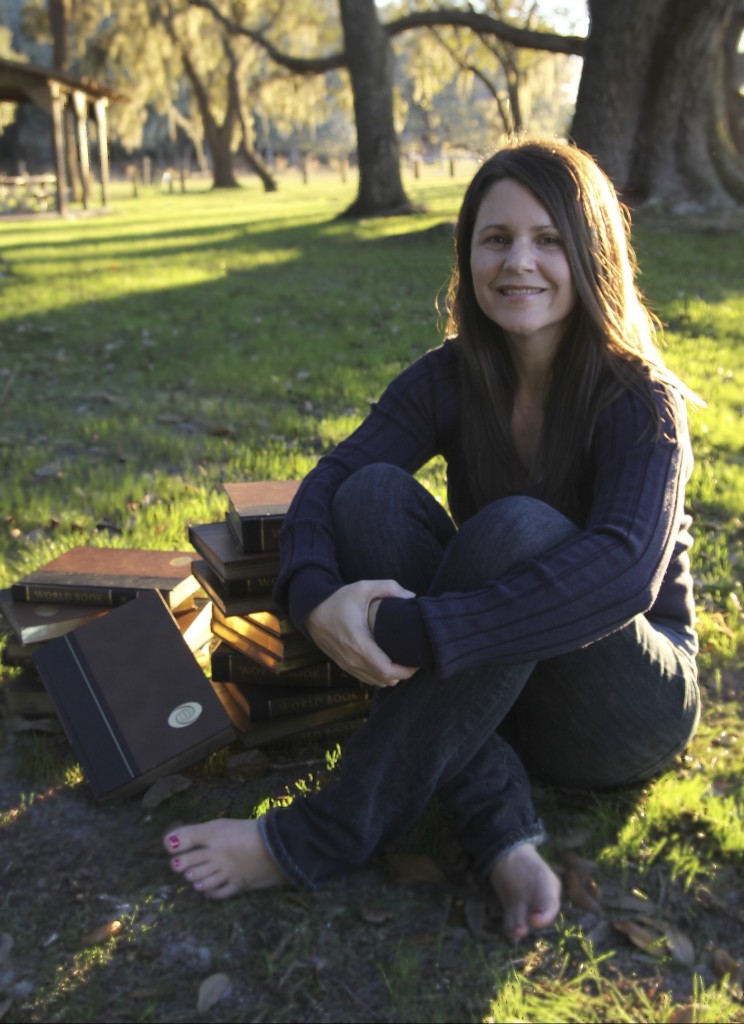
and pic 3:

Here are previews of the working copies of three of the book covers so you can see the pictures in ‘thumbnail’ form as they’ll be on the back cover. The actual handbooks are 6″ x 9″ so almost twice the size of these cover images which will make the pictures nearly double the size you see here:
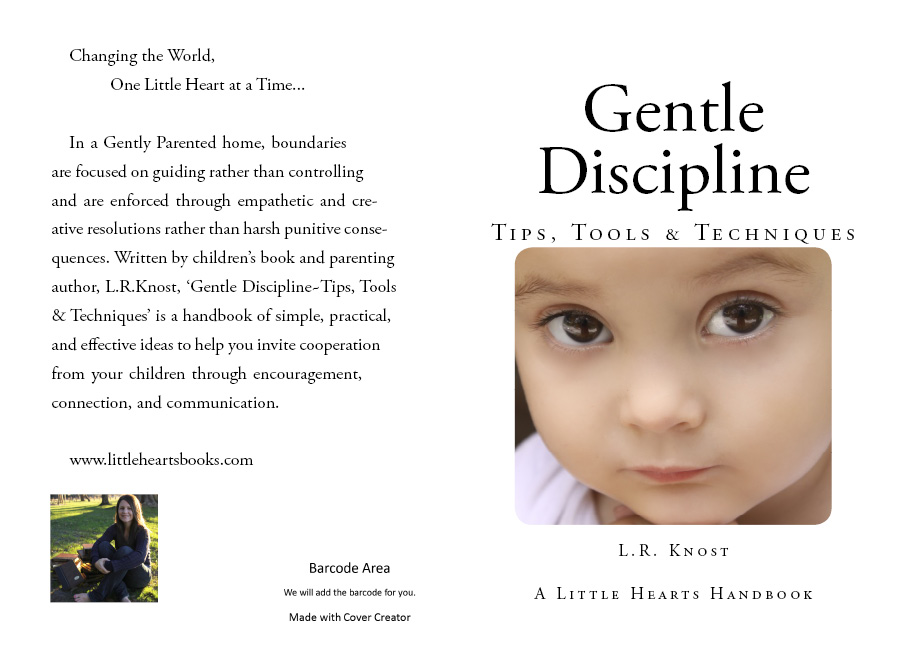
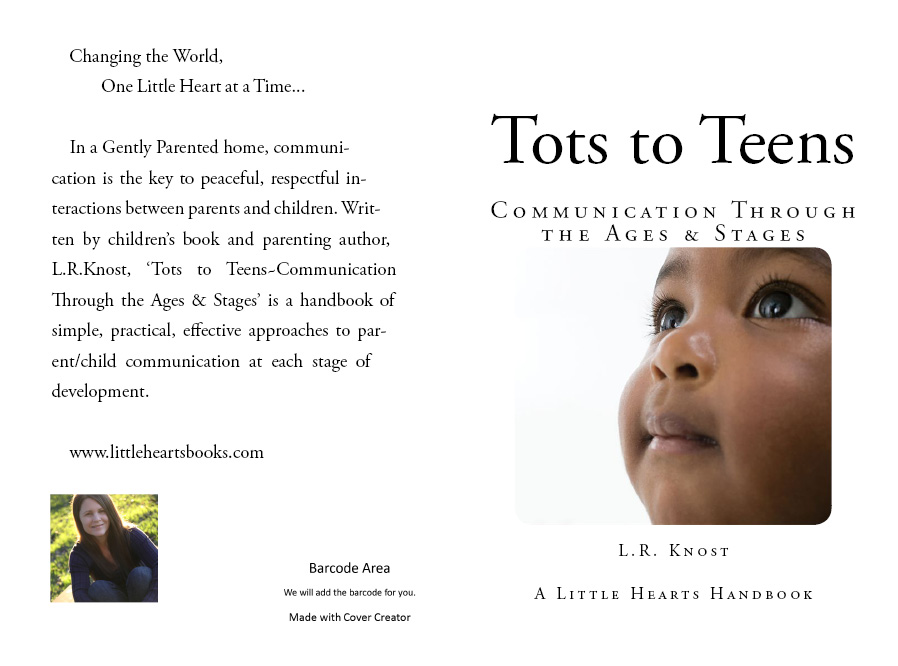
Okay, there you go! Vote for your favorite picture or leave a comment to register to win a free copy. It’s that easy!
 Award-winnning author, L.R.Knost, is the founder and director of the children's rights advocacy and family consulting group, Little Hearts/Gentle Parenting Resources, and Editor-in-Chief of Holistic Parenting Magazine. Books by L.R.Knost include Whispers Through Time: Communication Through the Ages and Stages of Childhood ; Two Thousand Kisses a Day: Gentle Parenting Through the Ages and Stages ; The Gentle Parent: Positive, Practical, Effective Discipline ; and Jesus, the Gentle Parent: Gentle Christian Parenting the first four books in the Little Hearts Handbook gentle parenting series, and children’s picture books Petey’s Listening Ears and the soon-to-be-released Grumpykins series.
Award-winnning author, L.R.Knost, is the founder and director of the children's rights advocacy and family consulting group, Little Hearts/Gentle Parenting Resources, and Editor-in-Chief of Holistic Parenting Magazine. Books by L.R.Knost include Whispers Through Time: Communication Through the Ages and Stages of Childhood ; Two Thousand Kisses a Day: Gentle Parenting Through the Ages and Stages ; The Gentle Parent: Positive, Practical, Effective Discipline ; and Jesus, the Gentle Parent: Gentle Christian Parenting the first four books in the Little Hearts Handbook gentle parenting series, and children’s picture books Petey’s Listening Ears and the soon-to-be-released Grumpykins series.
Bringing Up Binary: Raising an Obedient Computer
Dear Customer Service,
I think my computer needs professional help. I just don’t know what to do anymore. It won’t respond to me half of the time, and the other half its response is so slow it might as well not respond at all! I need help, and I don’t know where else to turn. Here’s the story:
 I remember how excited I was when I first got my computer. I carefully cut the tape on the box, gently lifted it out, and gingerly settled it in the well-appointed and super organized office I’d had decorated and waiting for what seemed like forever.
I remember how excited I was when I first got my computer. I carefully cut the tape on the box, gently lifted it out, and gingerly settled it in the well-appointed and super organized office I’d had decorated and waiting for what seemed like forever.
Now what to do? I’d never owned a computer before and was so nervous I’d somehow break it. I searched through manuals and how-to’s for dummies, looking for tips from experts and guidance from other computer owners with years of experience. It was so frustrating because everyone seemed to have a different opinion about what to expect and what was important and how to handle all the hardware and software issues that were bound to crop up with computer ownership.
Over time, though, I got more comfortable in my new role as a computer owner. My tentative key tapping became more confident, and I operated my computer like a pro. But then minor irritations began to creep up. I’d input a command and have to wait for my computer to process before it responded, but why should I have to wait? I’d issued the same commands hundreds of times since my computer had arrived. Shouldn’t it obey instantly? I certainly thought so! So, I’d push the enter button a couple more times, and then a couple more, then some other buttons, and the darn thing would freeze up on me!!! Seriously?!?
I’m no push-over, believe me, and I wasn’t about to be manipulated by my own computer! So, I started unplugging it every time it froze. After a few minutes, I’d plug it back in again, but even after extending its time-out of the outlet to longer and longer periods, my computer was still giving me that ring of delayed obedience and then freezing when I pushed its buttons. So, I started giving it a gentle whack on its CPU. (No, I was not abusing it. I was just giving it a little tap to get its attention!) But nothing seemed to be working. I was still having to wait for it to process my commands, and it was actually getting worse!
Then my computer started popping up demands, right in front of what I was working on! “Updates needed.” “Virus software update available.” Me, me, me. I want. I want. I want. Isn’t it amazing how completely self-absorbed computers are? Didn’t my computer realize I had a schedule to keep? I had things that needed to get done, an agenda, a life! And on top of all that, I’d just purchased a new little laptop that needed my attention. Why couldn’t my computer understand that it just had to do what it was told and stop giving me a hard time?!? Selfish, that’s why!
“Virus software update available.” Me, me, me. I want. I want. I want. Isn’t it amazing how completely self-absorbed computers are? Didn’t my computer realize I had a schedule to keep? I had things that needed to get done, an agenda, a life! And on top of all that, I’d just purchased a new little laptop that needed my attention. Why couldn’t my computer understand that it just had to do what it was told and stop giving me a hard time?!? Selfish, that’s why!
Well, time went on and my computer kept up it’s delayed obedience and just kept escalating its constant demands with pop up after pop up after pop up. But I knew better than to give in. All it wanted was attention! So I alternated between time-out of the outlet and well-deserved whacks to the CPU, but all I got was slower and slower obedience, longer and longer freezes, and just general unresponsiveness.
I’ve tried to be a good computer owner, but I’m at the end of my tether. Please help!
Sincerely,
Frustrated
Dear Frustrated,
Computers are designed to process input. Basically, that means you get out what you put in. That “demand for attention” is actually your computer communicating a need for input from you, whether it’s for an update  or a virus scan or whatever it’s indicating it needs. If you meet it’s needs, that will not only stop the “demands” but also free it up to run more smoothly and responsively for you. As far as the “delayed obedience,” that’s just how computers are built. It needs time to process your input so that it can respond appropriately. Pushing its buttons over and over is actually causing the freezing you’re concerned about, and unplugging your computer when it freezes just shuts it down right when it’s trying its hardest to work things out. Remember, interaction between owner and computer is the core of computer processing. Finally, stop “whacking” your computer. Call it what you want…hitting, tapping, popping, or whatever…it’s just causing internal damage and resulting in the very problems you’re trying to solve.
or a virus scan or whatever it’s indicating it needs. If you meet it’s needs, that will not only stop the “demands” but also free it up to run more smoothly and responsively for you. As far as the “delayed obedience,” that’s just how computers are built. It needs time to process your input so that it can respond appropriately. Pushing its buttons over and over is actually causing the freezing you’re concerned about, and unplugging your computer when it freezes just shuts it down right when it’s trying its hardest to work things out. Remember, interaction between owner and computer is the core of computer processing. Finally, stop “whacking” your computer. Call it what you want…hitting, tapping, popping, or whatever…it’s just causing internal damage and resulting in the very problems you’re trying to solve.
Sincerely,
Shak N. Mihed
Related posts:
The Measure of Success~Chinese Parents and French Parents Can’t BOTH Be Superior!
Spare the Rod: The Heart of the Matter
Tots to Teens~Communication Through the Ages and Stages
Toddlers, Tantrums, and Time-Ins, Oh My!
 Award-winnning author, L.R.Knost, is the founder and director of the children's rights advocacy and family consulting group, Little Hearts/Gentle Parenting Resources, and Editor-in-Chief of Holistic Parenting Magazine. Books by L.R.Knost include Whispers Through Time: Communication Through the Ages and Stages of Childhood ; Two Thousand Kisses a Day: Gentle Parenting Through the Ages and Stages ; The Gentle Parent: Positive, Practical, Effective Discipline ; and Jesus, the Gentle Parent: Gentle Christian Parenting the first four books in the Little Hearts Handbook gentle parenting series, and children’s picture books Petey’s Listening Ears and the soon-to-be-released Grumpykins series.
Award-winnning author, L.R.Knost, is the founder and director of the children's rights advocacy and family consulting group, Little Hearts/Gentle Parenting Resources, and Editor-in-Chief of Holistic Parenting Magazine. Books by L.R.Knost include Whispers Through Time: Communication Through the Ages and Stages of Childhood ; Two Thousand Kisses a Day: Gentle Parenting Through the Ages and Stages ; The Gentle Parent: Positive, Practical, Effective Discipline ; and Jesus, the Gentle Parent: Gentle Christian Parenting the first four books in the Little Hearts Handbook gentle parenting series, and children’s picture books Petey’s Listening Ears and the soon-to-be-released Grumpykins series.
It’s Okay to Praise Your Child, Just Like it’s Okay to ‘Like’ this Post
 As writers, we’ve all had the experience of publishing a piece we’ve worked hard putting together, and then posting it to Facebook, sharing it on Twitter, and pinning it on Pinterest…and having it just sit there, unliked, unshared, untweeted, and unpinned. Now, logically, we might know that only a small percentage of our audience sees what we share at any given time. And we know that, while some pieces we write hit just the right note at the right time and go flying around the blogosphere, others might need time to catch on or might simply remain a lonely, little, unread, unloved piece of ourselves that we’ve bravely put out there and the world has overlooked. But even knowing all of that, in those times when we share and no one hears us, when we bare our hearts and no one responds, the silence can feel like rejection, the work can feel pointless, the investment can feel wasted.
As writers, we’ve all had the experience of publishing a piece we’ve worked hard putting together, and then posting it to Facebook, sharing it on Twitter, and pinning it on Pinterest…and having it just sit there, unliked, unshared, untweeted, and unpinned. Now, logically, we might know that only a small percentage of our audience sees what we share at any given time. And we know that, while some pieces we write hit just the right note at the right time and go flying around the blogosphere, others might need time to catch on or might simply remain a lonely, little, unread, unloved piece of ourselves that we’ve bravely put out there and the world has overlooked. But even knowing all of that, in those times when we share and no one hears us, when we bare our hearts and no one responds, the silence can feel like rejection, the work can feel pointless, the investment can feel wasted.
Our readers have lives of their own that usually don’t include hours of research and writing and editing and formatting and tagging and linking. They may not realize that their likes, comments, and shares are major motivators for us. They might not understand that, while our passion for our message, whatever that may be, is what drives us, their response is like a pat on the back, and a simple “Well said!” can make our day. And they may not be remotely conscious of how deflating, demoralizing, and depressing that awkward, deafening silence can be when a post goes ignored.
Most of us don’t make a penny from our blogs, but we’re okay with the heavy time investment, the personal sacrifices, and the risks involved in sharing our hearts so transparently…as long as we are heard. And how do we know if we’re being heard? Our readers’ responses, their ‘likes,’ their pins and tweets and shares, and their comments that tell us they’re listening, that they care, and that they appreciate our work.
And what makes writers want to quit? What makes them want to shut down their laptops, hang up their message, and go back to watching sit-coms, reading books, or doing whatever they used to do when they actually had downtime? Well, certainly meanness from people who’d rather cause trouble than just move on to another site, for one, but often it’s simply the silence that drains away the motivation. Sharing your heart with a world that doesn’t respond makes a person feel small, insignificant, unappreciated.
Enter the child.
A child comes to his mother with a drawing that resembles a game of pick-up-sticks and proudly announces that he’s designed a new airplane. She grins and says, “Good job!” and he runs off happily to draw some more pick-up-stick inventions. But his mother is cringing at her choice of words, wishing she’d stopped mid-diaper change with the new baby and turned her full attention to her son and said something like, “I see that you worked hard. You used lots of colors,” or something, anything that didn’t pander to his need for attention or approval. What if she turned him into a ‘praise junkie’?!? Bad mom! she castigates herself. When her son returns a few minutes later and enthusiastically shows her his pick-up-stick submarine, she’s ready. She smiles awkwardly, nods her head and says, “You obviously are trying to use your imagination. I see that you are in a creative mood. What else are you going to invent today?” in a stiff and unnatural tone. Her son stands there for a moment, not quite sure how to respond, then shrugs and drifts off to another activity.
Now, clearly, using “Good job” as a brush-off in lieu of taking the time to pay any real attention to a child is the core issue that parenting experts are getting at when they encourage parents to focus on the child and the effort instead of the product or achievement. But so often parents read these kinds of articles and come away feeling, as a concerned mother recently expressed to me, “Like I’m doing it all wrong. I feel like I’m messing up my child when I tell him I like what he’s done.” That mother wasn’t brushing her child off with her praise. She was interacting with her child with a natural, honest enthusiasm that may now be damaged by something she read. It breaks my heart to think of her little guy running up to show her his latest creation only to be met with an unnatural and stilted response because his mother is afraid her instincts aren’t good enough.
Here’s the thing, a healthy, natural, loving parent/child relationship trumps all. It is the foundation for autonomy, not merely a satellite aid to independence. It is the wellspring of confidence and trust that leads to exploration, creativity, and innovation. It is the safe harbor from which daring and boldness and risk can be launched to take on the world.
A parent whose focus is on connection will respond to their child’s need in the moment, whether that need is praise for a job well done or encouragement in the face of failure. A parent focused on ‘getting the words right’ may well inadvertently leave their child’s present needs unmet because they are afraid to respond naturally.
Just as it is the hungry child, not the satisfied child, who craves food, it is unmet needs that lead to attention seeking behaviors and unspoken approval that can create ‘praise junkies’ as the unpraised child seeks to fill the very human need we all have for validation.
 Just as with adults, and specifically with those of us who are writers, children need to know they are being heard and appreciated. A ‘like’ on a post to us is like a pat on the back to a child, and a “Well said!” to a writer is like a “Good job!” to a child. In the same way that these acknowledgements don’t undermine our driving passions, but support and encourage them, spontaneous and sincere expressions of appreciation to a child don’t undermine a child’s passion to learn and grow and become. It is, in fact, the exact opposite. A parent’s sincere, spontaneous praise encourages and motivates a child to blossom in the warmth of their approval.
Just as with adults, and specifically with those of us who are writers, children need to know they are being heard and appreciated. A ‘like’ on a post to us is like a pat on the back to a child, and a “Well said!” to a writer is like a “Good job!” to a child. In the same way that these acknowledgements don’t undermine our driving passions, but support and encourage them, spontaneous and sincere expressions of appreciation to a child don’t undermine a child’s passion to learn and grow and become. It is, in fact, the exact opposite. A parent’s sincere, spontaneous praise encourages and motivates a child to blossom in the warmth of their approval.
With my six children, while they are infants I am happy to let them independently scoot and shuffle and roll in an effort to reach a toy, but I am there to offer help the second they express frustration so they will grow up knowing that they never have to struggle alone in life. When they are older and happily working on a drawing or popsicle-stick invention, I don’t hesitate to spontaneously express my enjoyment of their creation. That isn’t interference. It’s a connection point, a message that they don’t have to actively seek my approval for it to be theirs.
I know that the world won’t always treat my children kindly. I know that failure, disapproval, and rejection will inevitably be a part of their lives. But I want my children to grow up knowing that there is one place in the world where help is always available, and approval, acceptance, and appreciation are always freely offered. I want my children to have the assurance of a safe harbor to return to so that they will have the confidence to take on all the challenges the world will throw at them.
And so, parents, the message here is this: Read and research and educate yourself about all the various ideas and methods and theories about how to raise happy, healthy, confident children, but at the end of the day remember that you are your child’s parent. You love your child more and know them better than anyone else on earth. Don’t let anything stop you from responding naturally and lovingly to your child’s needs, whether those needs are for a high-five, a “Good job,” a thumb’s up, or just a great big bear hug.
Remember, the only bad praise is the sincerely meant praise that is silenced. ~L.R.Knost
“Well done, good and faithful servant.” Matt. 25:21
Listen to the sound of silence.
Related posts:
200 Ways to Bless Your Children with a Happy Childhood
Your Baby isn’t Trying to Annoy You; He’s Trying to Communicate!
Tots to Teens~Communication Through the Ages and Stages
3 Simple Steps from Diapers to Potty
A Place to Rest~Becoming Your Child’s Safe Harbor
Love in the Time of Cosleeping
 Award-winnning author, L.R.Knost, is the founder and director of the children's rights advocacy and family consulting group, Little Hearts/Gentle Parenting Resources, and Editor-in-Chief of Holistic Parenting Magazine. Books by L.R.Knost include Whispers Through Time: Communication Through the Ages and Stages of Childhood ; Two Thousand Kisses a Day: Gentle Parenting Through the Ages and Stages ; The Gentle Parent: Positive, Practical, Effective Discipline ; and Jesus, the Gentle Parent: Gentle Christian Parenting the first four books in the Little Hearts Handbook gentle parenting series, and children’s picture books Petey’s Listening Ears and the soon-to-be-released Grumpykins series.
Award-winnning author, L.R.Knost, is the founder and director of the children's rights advocacy and family consulting group, Little Hearts/Gentle Parenting Resources, and Editor-in-Chief of Holistic Parenting Magazine. Books by L.R.Knost include Whispers Through Time: Communication Through the Ages and Stages of Childhood ; Two Thousand Kisses a Day: Gentle Parenting Through the Ages and Stages ; The Gentle Parent: Positive, Practical, Effective Discipline ; and Jesus, the Gentle Parent: Gentle Christian Parenting the first four books in the Little Hearts Handbook gentle parenting series, and children’s picture books Petey’s Listening Ears and the soon-to-be-released Grumpykins series.
When Children Hit~10 Tips for Parents
[Portions reprinted from The Gentle Parent: Positive, Practical, Effective Discipline by L.R.Knost. Two Thousand Kisses a Day: Gentle Parenting Through the Ages and Stages and Whispers Through Time: Communication Through the Ages and Stages of Childhood also available on Amazon and through other major retailers.]
 Toddlers and preschoolers are still in the early stages of learning to communicate verbally. Add to that the fact that they have little-to-no impulse control and very immature social skills, and you’ve got a recipe for an instinctive physical response (i.e. hitting, kicking, biting, hair pulling, throwing things, etc.) to situations in which they are frustrated, angry, scared, or just tired and out-of-sorts.
Toddlers and preschoolers are still in the early stages of learning to communicate verbally. Add to that the fact that they have little-to-no impulse control and very immature social skills, and you’ve got a recipe for an instinctive physical response (i.e. hitting, kicking, biting, hair pulling, throwing things, etc.) to situations in which they are frustrated, angry, scared, or just tired and out-of-sorts.
Many parents who practice gentle discipline wonder where their little one picked up the behavior, not realizing that it is a normal and age-appropriate reaction, albeit an unacceptable one. Very often parents are advised to spank their child to train them not to hit others, especially those who are smaller and weaker than they are. (more…)
 Award-winnning author, L.R.Knost, is the founder and director of the children's rights advocacy and family consulting group, Little Hearts/Gentle Parenting Resources, and Editor-in-Chief of Holistic Parenting Magazine. Books by L.R.Knost include Whispers Through Time: Communication Through the Ages and Stages of Childhood ; Two Thousand Kisses a Day: Gentle Parenting Through the Ages and Stages ; The Gentle Parent: Positive, Practical, Effective Discipline ; and Jesus, the Gentle Parent: Gentle Christian Parenting the first four books in the Little Hearts Handbook gentle parenting series, and children’s picture books Petey’s Listening Ears and the soon-to-be-released Grumpykins series.
Award-winnning author, L.R.Knost, is the founder and director of the children's rights advocacy and family consulting group, Little Hearts/Gentle Parenting Resources, and Editor-in-Chief of Holistic Parenting Magazine. Books by L.R.Knost include Whispers Through Time: Communication Through the Ages and Stages of Childhood ; Two Thousand Kisses a Day: Gentle Parenting Through the Ages and Stages ; The Gentle Parent: Positive, Practical, Effective Discipline ; and Jesus, the Gentle Parent: Gentle Christian Parenting the first four books in the Little Hearts Handbook gentle parenting series, and children’s picture books Petey’s Listening Ears and the soon-to-be-released Grumpykins series.
You’re Not the Boss of Me!
 [Portions reprinted from The Gentle Parent: Positive, Practical, Effective Discipline by L.R.Knost. Two Thousand Kisses a Day: Gentle Parenting Through the Ages and Stages and Whispers Through Time: Communication Through the Ages and Stages of Childhood also available on Amazon and through other major retailers.]
[Portions reprinted from The Gentle Parent: Positive, Practical, Effective Discipline by L.R.Knost. Two Thousand Kisses a Day: Gentle Parenting Through the Ages and Stages and Whispers Through Time: Communication Through the Ages and Stages of Childhood also available on Amazon and through other major retailers.]
Few things ignite a parent’s temper like defiance. It feels like a slap in the face, a direct challenge to our authority. Power card…played. Gauntlet…thrown. Challenge…accepted?
Time out! No, not time-out as in punish your child, but time out as in hit the parental pause button, take a step back, assess the situation, and get some adult perspective.
There are three things to consider:
- Behaviors are communication. What is your child trying to communicate?
- Is the behavior really defiance, or did your child’s action hit a nerve in you for some reason?
- If the behavior is, in fact, defiance, what circumstances preceded it?
Once you’ve assessed the situation, you can more effectively address it. If your child is communicating an unmet need such as a need for more interaction from you, a need to be heard, or if they simply need an outlet for their energy, you can first meet those needs and then offer your child ideas about how to better communicate their needs to you in the future.
The same process applies if your child’s behavior is communicating stress, anger, fear, or insecurity. Taking a step back allows you to not only see the emotion behind the action, but also gives you a moment to consider if there have been any big transitions in your child’s life such as a move or change in childcare or a recent illness (or, possibly, a breach in trust if you have ‘lost it’ and yelled, threatened, or spanked) that they may have big feelings about but are not able to articulate. First you can meet those emotional needs with empathic listening, offering words to help them articulate their feelings, apologizing if you have broken trust with them, and providing an outlet for their pent up emotions. Then you can address their behavior by giving them options for expressing their needs in more acceptable ways.
Meeting their needs before addressing their behavior is vital because it lowers their defenses, clears whatever is cluttering up your parent/child connection, and opens the pathways to communication, in effect turning on their listening ears!
*On a side note, be aware that it is possible, especially with very young children, that what you are interpreting as defiance is actually age-appropriate curiosity and exploration. A twelve month old who repeatedly pulls the cat’s tail may be experimenting with the interesting sound the cat makes, the soft texture of the fur, her own feeling of power, or just trying to find out if pulling the tail is as ‘not-okay’ after her nap as it was before. Little ones too young to grasp the concept of permanence (typically those less than twenty-four to thirty months) live very much in the moment and cannot be expected to understand the permanent nature of rules and limits. Removing temptations (commonly referred to as baby-proofing) is not only for their safety, but is also a visual form of limit setting. A common misconception is that removing temptations is passive or indulgent parenting, but it is actually proactive parenting (whereas passive/indulgent parenting would be simply allowing the behavior) and is an effective and gentle beginning to the process of boundary setting.
If in taking a step back to assess the situation you discover that your child’s behavior isn’t really defiance, but a nerve was hit in you that caused you to perceive it that way, you can first address your child’s need and then their behavior, if necessary, but then take the time to address your own needs. Perhaps you have an unmet need to be heard by your spouse, boss, or even your own parents, or maybe there is a wound from your past that needs to be healed or a source of stress in your life that is causing you to feel overwhelmed. Taking an honest look at your own needs and hurts and stressors and dealing with those issues will not only benefit your parenting, but your life in general!
If your ‘time out’ assessment reveals that the circumstances preceding your child’s defiance contributed to it, you can learn from that and find ways to avoid those circumstances in the future. For instance, you may realize that hunger or tiredness or over-scheduling are triggers for your child’s behavior. Or you may see that your wording is provoking a negative response. (The word ‘no’ can be a trigger for a power struggle. Try rephrasing your no’s into yes’s. For instance, instead of “No, you can’t have ice cream until after dinner” you could try “I know you love ice cream. I do, too! We’re getting ready to eat right now, but what flavor would you like after dinner?” The objective is to set the same limit, but phrase it in a way that invites cooperation instead of triggering opposition.) You might realize you are inadvertently communicating your own stress to your child or even taking it out on them. Or you may have slipped into a negative parenting pattern and be ‘powering up’ on your child, in effect throwing down the gauntlet yourself, and they are merely reflecting your behavior. Whatever the case may be, learn from it, make the necessary adjustments, repair your relationship with an apology if needed, reconnect with your child, and then share ideas about better ways both of you can handle things in the future.
Keep in mind, though, that sometimes what parents perceive as defiance is really just a child testing their boundaries to make sure that they are secure. Children need to know they’re safe, and a parent who is confident and comfortable enough in their leadership to calmly and gently guide their child to stay within their boundaries is very reassuring. The goal of gentle parenting, however, is not controlling children, but equipping them to control themselves (in other words, we want to teach them to be ‘the boss’ of themselves!) So if your child is testing their boundaries, be careful to respond with guidance, not punishment.
Finally, remember, you are raising a little human with thoughts, needs, ideas, and a personality all their own. They aren’t perfect any more than you are, and expecting perfection will lead to conflict, not connection. When they make mistakes, choose understanding, not anger. When they make poor choices, choose guidance, not punishment. And when they challenge your authority and throw down that gauntlet of defiance, choose peace, not warfare. Remember, you don’t have to attend every fight you’re invited to!
~~~~~~~~~~~~~~
Related posts:
Toddlers, Tantrums, and Time-In’s, Oh My!
The Gift of a Strong-Willed Child
Backtalk is Communication…LISTEN
When Children Act Out ~ Reflecting Our Emotions
Bridge Over Troubled Waters~Parenting a ‘Problem’ Child
The Taming of the Tantrum: A Toddler’s Perspective
Practical, Gentle, Effective Discipline
200 Ways to Bless Your Children with a Happy Childhood
 Award-winnning author, L.R.Knost, is the founder and director of the children's rights advocacy and family consulting group, Little Hearts/Gentle Parenting Resources, and Editor-in-Chief of Holistic Parenting Magazine. Books by L.R.Knost include Whispers Through Time: Communication Through the Ages and Stages of Childhood ; Two Thousand Kisses a Day: Gentle Parenting Through the Ages and Stages ; The Gentle Parent: Positive, Practical, Effective Discipline ; and Jesus, the Gentle Parent: Gentle Christian Parenting the first four books in the Little Hearts Handbook gentle parenting series, and children’s picture books Petey’s Listening Ears and the soon-to-be-released Grumpykins series.
Award-winnning author, L.R.Knost, is the founder and director of the children's rights advocacy and family consulting group, Little Hearts/Gentle Parenting Resources, and Editor-in-Chief of Holistic Parenting Magazine. Books by L.R.Knost include Whispers Through Time: Communication Through the Ages and Stages of Childhood ; Two Thousand Kisses a Day: Gentle Parenting Through the Ages and Stages ; The Gentle Parent: Positive, Practical, Effective Discipline ; and Jesus, the Gentle Parent: Gentle Christian Parenting the first four books in the Little Hearts Handbook gentle parenting series, and children’s picture books Petey’s Listening Ears and the soon-to-be-released Grumpykins series.
The Trouble With Kids Today
[Portions reprinted from Two Thousand Kisses a Day: Gentle Parenting Through the Ages and Stages by L.R.Knost available on Amazon]
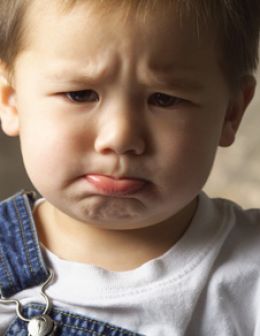 “People are telling parents like me that we are failing our children because we practice controlled discipline in our homes. I say: the children that are raised without it are the ones being abused and robbed of the chance of success in adulthood.” Controlled discipline in the eyes of this author of I Don’t Like Spanking My Kids, But I Do It Anyway is physical punishment. Equating discipline with punishment is a common misconception, but she is, unfortunately, not alone in her stance.
“People are telling parents like me that we are failing our children because we practice controlled discipline in our homes. I say: the children that are raised without it are the ones being abused and robbed of the chance of success in adulthood.” Controlled discipline in the eyes of this author of I Don’t Like Spanking My Kids, But I Do It Anyway is physical punishment. Equating discipline with punishment is a common misconception, but she is, unfortunately, not alone in her stance.
Many of today’s most popular self-proclaimed parenting ‘experts’ also equate physical punishment with discipline and go to great lengths to describe the best methods and tools for hitting children along with instructing parents to maintain a calm, controlled, and even cheerful demeanor as they ‘lovingly’ hit their children.
It is interesting to note here that, when it comes to the law, crimes of passion are treated as less heinous than premeditated, planned, and purposefully executed crimes which are termed ‘in cold blood.’ And yet when physically punishing a child, a crime in many places across the globe, hitting in anger or frustration (i.e. passion) is deemed wrong by proponents of spanking, while hitting children with calm and deliberate intent (i.e. premeditation) is encouraged.
It is also interesting to note that, in the not-too-distant past, husbands hitting their wives was also viewed as not only a societal norm, but a necessary part of maintaining a harmonious, successful marriage. In fact, a man who epitomizes the words calm and controlled, Sean Connery, shared his thoughts on the ‘reasonable smacking’ of his wife in a 1987 interview with Barbara Walters:
The core belief behind ‘reasonable smacking’ of wives was that there was no other effective way to control them. I have to agree. If controlling another human being is the goal, then force is necessary. Fear, intimidation, threats, power-plays, physical pain, those are the means of control.
But if growing healthy humans is the goal, then building trust relationships, encouraging, guiding, leading, teaching, communicating, those are the tools for success.
Many parents simply don’t know what else to do. They were raised with spanking as a means of control and “turned out okay” so they default to their own parents’ parenting choices without researching alternatives to spanking or considering whether “okay” could be improved upon.
As to the I Don’t Like Spanking My Kids, But I Do It Anyway author’s contention that “We are raising a generation of children who are over-sensitive because they eventually find out that they aren’t as good at baseball or ballet as some other kid and their parents promised them that everyone is equal. They feel entitled because we teach them that they should. They throw tantrums when life doesn’t go their way because their parents have tiptoed around them to make sure that it does,” that reasoning sounds strangely familiar.
People throughout history have complained about ‘the trouble with kids these days.’ They’ve pinned all the ills of their society on permissive parenting. They’ve ranted about out-of-control children, disrespectful youth, entitlement, spoiling, disobedience, violence, self-centeredness, etc:
“The children now love luxury. They have bad manners, contempt for authority, they show disrespect to their elders…. They no longer rise when elders enter the room. They contradict their parents, chatter before company, gobble up dainties at the table, cross their legs, and are tyrants over their teachers.”
~Socrates, 5th Century BC“What is happening to our young people? They disrespect their elders, they disobey their parents. They ignore the law. They riot in the streets inflamed with wild notions.
Their morals are decaying. What is to become of them?”
~Plato, 5th Century BC“I see no hope for the future of our people if they are dependent on frivolous youth of today, for certainly all youth are reckless beyond words… When I was young, we were taught to be discreet and
respectful of elders, but the present youth are exceedingly wise [disrespectful] and impatient of restraint”
~Hesiod, 8th Century BC“The world is passing through troublous times. The young people of today think of nothing but themselves. They have no reverence for parents or old age. They are impatient of all restraint. They talk as if they knew everything, and what passes for wisdom with us is foolishness with them. As for the girls, they are forward, immodest and unladylike in speech, behavior and dress.”
~Peter the Hermit, 13th Century ADMy grandpa notes the world’s worn cogs
And says we’re going to the dogs.
His grandpa in his house of logs
Said things were going to the dogs.
His grandpa in the Flemish bogs
Said things were going to the dogs.
His grandpa in his hairy togs
Said things were going to the dogs.
But this is what I wish to state:
The dogs have had an awful wait.
~Unknown, circa 1936Small children disturb your sleep, big children your life.
~Yiddish Proverb
Perhaps, just perhaps, there isn’t any ‘trouble with kids today.’ Maybe the trouble is with societies who view normal stages of development as somehow abnormal. Maybe the problem is with parents who repeat the patterns their own parents set and don’t delve into the belief system they are now passing along to their children. Or maybe the problem is simply the rose-colored glasses older generations tend to have about their own youth when they share idealized versions of ‘the good old days.’
Could it be that ‘kid’s today’ are just kids like they have been through the ages, full of exuberance and curiosity and learning their way in a great big world? Could it be that a listening ear, gentle guidance, and trusted arms to turn to when inevitable mistakes are made are really all children need to grow up into kind, helpful, responsible, productive members of our society?
Consider this, “Since more than 90% of American parents admit to spanking their children, it’s hard to accept that a decline in spanking is responsible for the purportedly escalating rates of youth violence and crime. Could it be that the 90% of children who are subject to violence at home in the form of being slapped, paddled, smacked, yanked, whipped, popped, spanked, etc. are taking those lessons out into the world? Is it just possible that children who are hit learn to hit? That children who are hurt learn to hurt? Perhaps the lesson they are learning is that ‘might is right’ and violence is the answer to their problems, the outlet for their stress, the route to getting others to do what they want.” Better Children, Better World
Could it be that sowing peace in our homes is the answer after all?
Related posts:
Practical, Gentle, Effective Discipline
Spare the Rod: The Heart of the Matter
Tots to Teens~Communication Through the Ages and Stages
Testing the Boundaries~What’s A Parent To Do?
One Slippery Sock & Other Silly Tools for your Parenting Toolbox!
The Measure of Success~Chinese Parents and French Parents Can’t BOTH Be Superior!
 Award-winnning author, L.R.Knost, is the founder and director of the children's rights advocacy and family consulting group, Little Hearts/Gentle Parenting Resources, and Editor-in-Chief of Holistic Parenting Magazine. Books by L.R.Knost include Whispers Through Time: Communication Through the Ages and Stages of Childhood ; Two Thousand Kisses a Day: Gentle Parenting Through the Ages and Stages ; The Gentle Parent: Positive, Practical, Effective Discipline ; and Jesus, the Gentle Parent: Gentle Christian Parenting the first four books in the Little Hearts Handbook gentle parenting series, and children’s picture books Petey’s Listening Ears and the soon-to-be-released Grumpykins series.
Award-winnning author, L.R.Knost, is the founder and director of the children's rights advocacy and family consulting group, Little Hearts/Gentle Parenting Resources, and Editor-in-Chief of Holistic Parenting Magazine. Books by L.R.Knost include Whispers Through Time: Communication Through the Ages and Stages of Childhood ; Two Thousand Kisses a Day: Gentle Parenting Through the Ages and Stages ; The Gentle Parent: Positive, Practical, Effective Discipline ; and Jesus, the Gentle Parent: Gentle Christian Parenting the first four books in the Little Hearts Handbook gentle parenting series, and children’s picture books Petey’s Listening Ears and the soon-to-be-released Grumpykins series.
Death of a Butterfly: Helping Children Cope with Loss

[Reprinted from Two Thousand Kisses a Day: Gentle Parenting Through the Ages and Stages by L.R.Knost. Whispers Through Time: Communication Through the Ages and Stages of Childhood and The Gentle Parent: Positive, Practical, Effective Discipline also now available on Amazon and through other major retailers.]
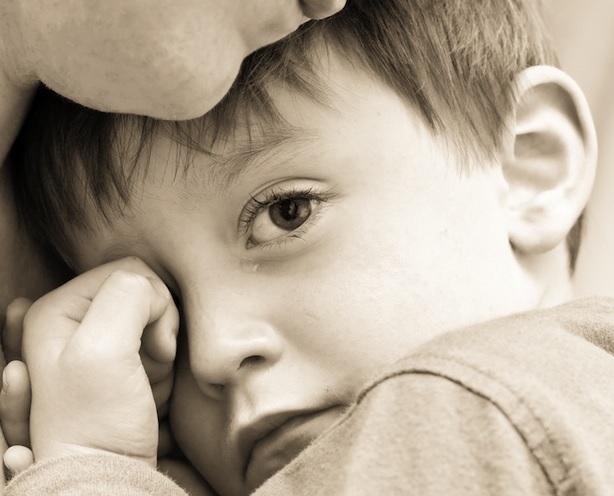 My little Funny Face accidentally killed a butterfly today. Her sweet little heart is broken, poor thing. We’re walking through the stages of mourning together as I use these small (to us adults) losses to equip her with healthy tools for handling the difficult things life will surely bring through the years, as it does to all of us. Whether it’s the death of a butterfly, the loss of a favorite stuffed animal, or another loss that matters to them deeply, guiding children through their uncomfortable and often overwhelming emotions is something parents are often unprepared to handle. Here are the steps we take together when life gets hard and loss becomes a reality to my children:
My little Funny Face accidentally killed a butterfly today. Her sweet little heart is broken, poor thing. We’re walking through the stages of mourning together as I use these small (to us adults) losses to equip her with healthy tools for handling the difficult things life will surely bring through the years, as it does to all of us. Whether it’s the death of a butterfly, the loss of a favorite stuffed animal, or another loss that matters to them deeply, guiding children through their uncomfortable and often overwhelming emotions is something parents are often unprepared to handle. Here are the steps we take together when life gets hard and loss becomes a reality to my children:
1.) Feeling~The first step is simply allowing my children to feel their emotions. If they’re crying, I listen to their cues to know when to offer hugs or if they need some time alone or just someone to sit quietly next to them. If they’re angry, I watch closely to see if they need some directions for a safe outlet such as punching a pillow or going outside to kick a ball or if they are able to just stomp around and get it out that way. If they are unnaturally quiet, I let them know I’m there if they need me and then I leave them alone to sort through their emotions in their own time.
2.) Expressing~The second step is guiding my children to express their feelings in some tangible form. This step begins either when they initiate a conversation about the loss or when I see that their emotions are getting the best of them, indicating that they need some assistance in moving forward. This step may take the form of simply talking through what they are feeling, but typically it includes drawing a picture, making up a song or dictating a poem for me to write down for them, making a memory box, or some combination of each of them.
3.) Refocusing~The third and last step is giving my children ideas about how to move on. It’s often hard for them to figure out how to redirect their thoughts from constantly swirling around their loss. It takes a measure of mental maturity to be able to focus elsewhere when emotions are running high. This is not to say that they should never think about their loss again. I am always open to listening to their feelings and sharing their memories with them. This last step is just gently helping them to consciously shift their attention from what they have lost to what they still have, moving their thoughts from loss to life. This step often takes the form of encouraging them to head outside and play in the mud or climb a tree, or it might be offering to read them a favorite book or play a board game with them or maybe inviting a friend over to play.
While these three steps are in no way exhaustive, the idea behind this process is to simplify the stages of grief in a way that is accessible to parents and understandable to children. And then, when life hits hard and big losses occur such as the loss of a loved one, divorcing parents, etc. having walked through these small losses with our children sets the stage for helping them to work through the harder things while preserving a healthy parent/child connection.
When big life losses do occur, staying in tune with our children and letting them ask questions freely while we work to temper our answers in age appropriate terms is vital. Watching for changes in their behavior helps to give us clues as to what they’re feeling. If they start having trouble sleeping or resisting going to school or having meltdowns, etc. it might be helpful to seek out professional counseling for a brief time. We also need to keep in mind that small children have active imaginations and the line between fantasy and reality is very blurry for them. Death may not impact them much at all if the reality of it doesn’t sink in, or, on the flip side it could have a significant impact and they could begin to imagine all sorts of awful things happening to them or their family or friends. It’s important to let our children lead the way as to how we need to help them cope. Our local library or online at Goodreads or Amazon’s Listopia can also be good resources for age appropriate books on death and grief to share with our children. We do need to be sure to read through them ourselves first to make sure we’re comfortable with how things are presented, though.
Here is a brief, generic ‘script’ that can be used as a starting point for sharing difficult news about a loss with our children:
“I have something to tell you, and it’s a very hard thing. I want you to know that you are safe, and I’m safe, and I’m right here to help you, okay?”
(Give them time to respond.)
“Your (grandpa, aunt, friend, etc.), *name,* died. Do you know what ‘died’ means?”
(Give them time to respond.)
“It means they’re gone to (fill in your belief), and they won’t be coming back.”
(Give them time to respond.)
“It’s okay to be sad or even angry or scared. Those are normal emotions when people die. We are all very sad because we’re going to miss *name.*”
(Give them time to respond.)
“You’ll probably need some time to think about what happened, and you’ll probably have questions. That’s okay. And it’s okay to talk about *name,* too. We all are going to miss *name* and talking about them can help us to remember happy times with them.”
(Give them time to respond.)
“Would you like to make a goodbye card or a memory box? That might help you to feel better.”
Obviously this is a generic script that will need to be adapted based on a child’s responses, but it provides a starting point to open the conversation and begin to walk them through the grieving and healing process. Time does heal, but often it isn’t simply the passage of time that heals, but rather the support and comfort from those with whom we spend that time.
Related posts:
Children in the three to six-year-old age range are beginning to realize that their parents aren’t the all-powerful beings that they once believed them to be. This realization can be very uncomfortable for them, causing them a great deal of unease as they are concurrently beginning to realize that there is a whole, big, wide world beyond their safe, little home, a that the world is full of potential dangers, hazards unknown, and just a lot of really big, scary things. So what is a parent to do with their newly timid little house-mouse? The Age of Fear~Young Children and Anxiety
 Award-winnning author, L.R.Knost, is the founder and director of the children's rights advocacy and family consulting group, Little Hearts/Gentle Parenting Resources, and Editor-in-Chief of Holistic Parenting Magazine. Books by L.R.Knost include Whispers Through Time: Communication Through the Ages and Stages of Childhood ; Two Thousand Kisses a Day: Gentle Parenting Through the Ages and Stages ; The Gentle Parent: Positive, Practical, Effective Discipline ; and Jesus, the Gentle Parent: Gentle Christian Parenting the first four books in the Little Hearts Handbook gentle parenting series, and children’s picture books Petey’s Listening Ears and the soon-to-be-released Grumpykins series.
Award-winnning author, L.R.Knost, is the founder and director of the children's rights advocacy and family consulting group, Little Hearts/Gentle Parenting Resources, and Editor-in-Chief of Holistic Parenting Magazine. Books by L.R.Knost include Whispers Through Time: Communication Through the Ages and Stages of Childhood ; Two Thousand Kisses a Day: Gentle Parenting Through the Ages and Stages ; The Gentle Parent: Positive, Practical, Effective Discipline ; and Jesus, the Gentle Parent: Gentle Christian Parenting the first four books in the Little Hearts Handbook gentle parenting series, and children’s picture books Petey’s Listening Ears and the soon-to-be-released Grumpykins series.
The Age of Fear: 8 Tips to Help Young Children Cope with Anxiety
[Reprinted from Two Thousand Kisses a Day: Gentle Parenting Through the Ages and Stages by L.R.Knost. Whispers Through Time: Communication Through the Ages and Stages of Childhood and The Gentle Parent: Positive, Practical, Effective Discipline also now available on Amazon and through other major retailers.]
Your once fearless five-year-old suddenly refuses to leave your side at the park saying, “I’m afraid the birds will eat me,” while eyeing the tiny swallows hopping on the ground as if they’re evil geniuses plotting his demise.
Your three-year-old, whom you once found proudly grinning while sitting atop the refrigerator, has abruptly decided the swings are objects of abject terror that will, “Fly me to the ground.” (Translation: I’ll fall off!)
Your six-year-old who has slept like a log in his own bed for years is suddenly resisting bedtime and climbing into your bed with you at 3 am every. single. night.
Your happy little four-year-old suddenly becomes withdrawn and clingy, refusing to play with her playdate friends and wanting to sit in your lap. And, even worse, she’s started sucking her thumb again!
The preschool and early elementary school years are sometimes marred with exaggerated fears, odd anxieties, nightmares, night terrors, and other evidences of insecurity that can make the most confident of parents feel a combination of dismay, frustration, worry, and failure. Regression is a common accompaniment, from pottying accidents to night-waking to thumb-sucking. Often, acting-out behaviors also increase in this time period.
So, what in the world is going on?
No, it’s not an environmental-toxin-induced, super-early-onset of adolescent-hormone-overload. And, normally, it’s not a trauma-reaction to life changes such as moving or starting preschool or school, though those events can exacerbate the issue. (Be aware that these behaviors can, rarely, indicate an anxiety disorder, stress-overload, or abuse. If you suspect any of these things may be causing your child’s behavior, seek a professional evaluation.)
Typically, though, sudden anxiety behaviors in preschool/early elementary aged children are simply another normal stage of development, an indication of cognitive growth. In other words, as odd as it sounds, fear can be a sign of maturity!
Children in the three to six-year-old age range (Keep in mind that this is a rough age estimate. Children are individuals, not pre-programmed robots!) are beginning to realize that their parents aren’t the all-powerful beings that they once believed them to be. This realization can be very uncomfortable for them, causing them a great deal of unease as they are concurrently beginning to realize that there is a whole, big, wide world beyond their safe, little home, and that that world is full of potential dangers, hazards unknown, and just a lot of really big, scary things.
So what is a parent to do with their newly timid little house-mouse?
First, be aware that there is no one-size-fits-all miracle ‘cure.’ You know your child better than anyone else, and being responsive to her unique needs means taking your cues from her as to what may help or hinder her journey through this uncomfortable stage.
That said, here are some ideas that may help:
- Before forcing your child to ‘face his fears,’ consider whether someone throwing a spider on you if you are deathly afraid of spiders or locking you in a closet if you’re claustrophobic would be helpful to you in overcoming your fears. If the answer is ‘NO!’ then honor your child’s feelings and move on to another solution.
- When your child voices her concerns, resist the urge to minimize them. If she says, “I’m afraid of monsters coming in my window,” try not to say, “There’s no such thing as monsters.” Remember, she’s realizing you aren’t all-powerful, and that means you aren’t all-knowing, either! Rather than be reassured by your words, she’ll simply think you don’t know about the monsters and can’t help her and keep her safe. Instead, you can brainstorm ideas together to keep the monsters at bay. While you don’t want to say that monsters actually do exist, you can say something like, “Let’s think of ways to keep you safe. What if daddy throws the monsters away in the trashcans outside and the trashman takes them away?” Don’t be afraid to be seriously silly. In other words, take her fears seriously, but offer silly solutions that offer visuals of the monsters (or whatever the fear is) going away forever.
- Help your child to make a ‘nightmare safe’ out of a shoe box. At night
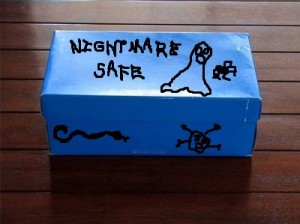 before he goes to bed, sit with him and encourage him to put all his scary thoughts in the box for you to take and keep safely away from him while he sleeps. Let him know that if he does have a bad dream, he can come to you even if it’s the middle of the night, and you’ll help him to put the scary dream in the box so he’ll be able to go back to sleep.
before he goes to bed, sit with him and encourage him to put all his scary thoughts in the box for you to take and keep safely away from him while he sleeps. Let him know that if he does have a bad dream, he can come to you even if it’s the middle of the night, and you’ll help him to put the scary dream in the box so he’ll be able to go back to sleep.
- Avoid phrases such as “You’re a big boy now” and “Only babies do that.” Focus instead on encouraging your child to do the things you know he can do. For instance, if he’s usually able to climb the ladder on the slide but gets ‘stuck’ halfway up and asks for help, start by moving near so he knows you are close and willing to help him if needed. Then verbally encourage him, “I know you can do it. I’m here if you need me.” But don’t pressure him. If he gets upset or insists he can’t do it, help him down. Remember, it isn’t really about the slide at all. It’s about seeking reassurance that you can still be trusted to take care of him, that he’s still safe with you.
-
 If the occasional monster in the closet or under the bed needs to be evicted, try reading a book like Go Away, Big Green Monster! and make your own ‘Monster-Away Spray,’ to send all the scary monsters packing. The ones we made didn’t match the colors in the book perfectly because we just used foam stickers and googlie eyes from our craft box and blue spray bottles from the bargain bin at the fabric store, but my girls were thrilled with them. We filled them with water (and added a little spritz of febreeze in my six-year-old’s bottle because, “Monsters can’t STAND flowers!”) and then Daddy and Big Brother took turns pretending to be monsters and ran away squealing from the girls when they got sprayed. Role-playing with children (and just playing with them, period!) is a powerful tool in helping them learn coping skills. Now, a bit of bedtime spritzing in closets and under beds is all it takes to make my girls feel confident that they’ve rousted the beasties so they can sleep in peace!
If the occasional monster in the closet or under the bed needs to be evicted, try reading a book like Go Away, Big Green Monster! and make your own ‘Monster-Away Spray,’ to send all the scary monsters packing. The ones we made didn’t match the colors in the book perfectly because we just used foam stickers and googlie eyes from our craft box and blue spray bottles from the bargain bin at the fabric store, but my girls were thrilled with them. We filled them with water (and added a little spritz of febreeze in my six-year-old’s bottle because, “Monsters can’t STAND flowers!”) and then Daddy and Big Brother took turns pretending to be monsters and ran away squealing from the girls when they got sprayed. Role-playing with children (and just playing with them, period!) is a powerful tool in helping them learn coping skills. Now, a bit of bedtime spritzing in closets and under beds is all it takes to make my girls feel confident that they’ve rousted the beasties so they can sleep in peace!
- If regression is an issue, keep in mind that your child is self-comforting by returning to a time she felt safe. Rather than punishing, ridiculing, bribing, or in other ways trying to ‘control’ the behavior, offer comfort in appropriate ways to demonstrate that she can trust you to meet her comfort/safety needs. This applies to acting-out behaviors, as well. Set boundaries, certainly, and provide plenty of guidance, but remember that punishment tends to push children farther away rather than connecting with them. Since your child is reacting to a feeling of disconnection from you in her new understanding of your non-superhero status, pushing her further away will merely exacerbate the issue, not solve it.
- Just listen. This is the simplest solution to a rather complex problem. Slow down and make time to just take a walk with your child. Sit with him in the evening and watch him color or play a quiet board game with him. Lay with him in his bed for a few minutes before he sleeps and chat about the day. Just the fact of you taking the time to focus on him, to be quiet with him, to enjoy his company, and to reconnect with him will go a long way towards soothing his fears.
- Even if your child isn’t introverted by nature, the following table offers some wonderful tips that translate well into this brief anxiety stage:
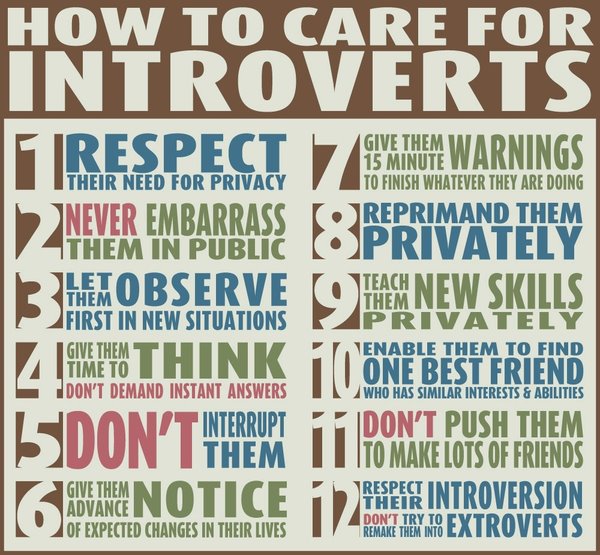
Remember, just like all the other stages of development, this ‘age of fear’ won’t last forever. Staying connected with your child and keeping the communication lines open through the ages and stages of development will help to ease their way as well as keeping your relationship strong and healthy.
Related posts:
Toddlers, Tantrums, and Time-Ins, Oh My!
Testing the Boundaries~What’s A Parent To Do?
To a Toddler Sharing is a 4 Letter Word~MINE!
Babes and Boundaries~A Gentle Parenting Perspective
Your Baby isn’t Trying to Annoy You; He’s Trying to Communicate!
 Award-winnning author, L.R.Knost, is the founder and director of the children's rights advocacy and family consulting group, Little Hearts/Gentle Parenting Resources, and Editor-in-Chief of Holistic Parenting Magazine. Books by L.R.Knost include Whispers Through Time: Communication Through the Ages and Stages of Childhood ; Two Thousand Kisses a Day: Gentle Parenting Through the Ages and Stages ; The Gentle Parent: Positive, Practical, Effective Discipline ; and Jesus, the Gentle Parent: Gentle Christian Parenting the first four books in the Little Hearts Handbook gentle parenting series, and children’s picture books Petey’s Listening Ears and the soon-to-be-released Grumpykins series.
Award-winnning author, L.R.Knost, is the founder and director of the children's rights advocacy and family consulting group, Little Hearts/Gentle Parenting Resources, and Editor-in-Chief of Holistic Parenting Magazine. Books by L.R.Knost include Whispers Through Time: Communication Through the Ages and Stages of Childhood ; Two Thousand Kisses a Day: Gentle Parenting Through the Ages and Stages ; The Gentle Parent: Positive, Practical, Effective Discipline ; and Jesus, the Gentle Parent: Gentle Christian Parenting the first four books in the Little Hearts Handbook gentle parenting series, and children’s picture books Petey’s Listening Ears and the soon-to-be-released Grumpykins series.
Raising Super Readers~The MARVELous Power of Comic Books!
 Captain America made his comic book debut on this day in 1941. He embodied the American Dream, a nobody who became a somebody, an everyday, struggling, working class American who became a hero.
Captain America made his comic book debut on this day in 1941. He embodied the American Dream, a nobody who became a somebody, an everyday, struggling, working class American who became a hero.
For Captain America, the dream became a reality because of a diabolical villain trying to take over the world and a risky scientific experiment to create a hero who could stop him. (Seriously, though, who would really let strangers stick them in a radiation chamber and inject green slime into their body?!?)
For children who feel like nobodies, though, who struggle everyday, who have to work harder in class than their peers, Captain America might just be the key to unlocking the power to read.
Children like My Renaissance Girl who struggle with severe dyslexia and/or other learning disabilities as well as children who don’t have learning disabilities but are reluctant readers [ImaginationSoup.net] often rely heavily upon illustrations to help them keep track of the storyline. This provides them with the motivation to continue to read, which in turn increases their ability to read, thus increasing their motivation to read…success leading to success…a virtuous circle!
However a problem arises because, while high quality, beautifully illustrated children’s picture books abound, books appropriate for and of interest to older children often are either sparsely illustrated or not illustrated at all.
Enter the comic book!
Comic books, now generally known as graphic novels, have increasingly been finding their way into classrooms and school libraries as teachers search for tools to not only help their students learn how to read, but to tap into the vivid imagination that is the hallmark of childhood and turn their students onto a lifelong love of reading.
The Graphic Classroom founder, Chris Wilson, has made it his mission to seek out excellent graphic novels covering a wide range of subjects and styles and get them into the public education system here in the U.S.
From Da Vinci: The Renaissance Man to The Action Bible, the graphic novel industry has come a long way from the days of Archie and Jughead. The venerable Stan Lee, himself a rags to riches story on the order of his Marvel character, Captain America, is credited with a large portion of the popularity of the ever more sophisticated world of the graphic novel. His relatable characters, real-world storylines, conversational style, and stunning graphic art have contributed immeasurably to the emergence of graphic novels from the dark ages of the dime store shelves to a powerhouse industry with much to offer the literary world.
When it comes to literacy, Stan Lee brought his own superpowers into play with the formation of the Stan Lee Foundation “to do whatever I could to fight illiteracy in children. Any child who grows up illiterate, unable to read and write — or even semi-literate — can be considered handicapped. Competition throughout the world has grown so keen that every young person needs every possible advantage to even the competitive playing field. The ability to read well, to study, comprehend, and process information is absolutely vital for success as an adult.”
Utilizing graphics in teaching reading is certainly not a foreign concept. Picture books for younger children have been used for centuries to interest children in the written word. (Check out this incredibly cool Superhero ABC graphic art novel for early childhood education!) But incorporating art in the form of illustrations and graphics into curriculum for older students seems to be a relatively new and somewhat controversial concept as evidenced by the Common Core State Standards [Education Week] being adopted in all but three states so far which states “the text should be central, and surrounding materials should be included only when necessary, so as not to distract from the text itself.”
Clearly, the object of the Common Core State Standards is to focus on the mechanics of reading, in effect producing students able to read manuals and textbooks, but with no engagement of the heart, no delighting of the soul, no enrichment of the imagination. In short, the purpose seems to be to produce a generation of automatons who can pass a test on Da Vinci, but can’t think or create or imagine or invent like Da Vinci.
When you consider that “Reading correlates with almost every measurement of positive personal and social behavior surveyed, from scholarship and job success to voting and playing sports.” [BookReporter.com], it makes more sense to raise bookworms than to program robots.
Successful reading means far more than possessing the ability to read. Engaging the hearts of students moves reading success beyond a life skill and turns it into a life style. Children who love to read…READ. Adults who love to read…READ. And graphic novels are too powerful of a tool in our arsenal to be disregarded because of pride or prejudice.
~Excelsior
Related posts:
Children who love to read…READ! Engaging children’s hearts in the wonder of reading instead of just training their minds in its mechanics. Raising Bookworms
8 Reasons to Let Your Kids Read Comics. Imagination Soup
It’s time for a return to childhood, to simplicity, to running and climbing and laughing in the sunshine, to experiencing happiness instead of being trained for a lifetime of pursuing happiness…it’s time to let children be children again. A Return to Childhood
Think homeschooled children are unsocialized, over-controlled, locked-away-from-the-world misfits? Think again! My Renaissance Girl
Playground Confessions~Look Who’s Talking!
Alphabet Fun~Imagination From A to Z!
Live to Play~Play to Learn~Learn to Live!
 Award-winnning author, L.R.Knost, is the founder and director of the children's rights advocacy and family consulting group, Little Hearts/Gentle Parenting Resources, and Editor-in-Chief of Holistic Parenting Magazine. Books by L.R.Knost include Whispers Through Time: Communication Through the Ages and Stages of Childhood ; Two Thousand Kisses a Day: Gentle Parenting Through the Ages and Stages ; The Gentle Parent: Positive, Practical, Effective Discipline ; and Jesus, the Gentle Parent: Gentle Christian Parenting the first four books in the Little Hearts Handbook gentle parenting series, and children’s picture books Petey’s Listening Ears and the soon-to-be-released Grumpykins series.
Award-winnning author, L.R.Knost, is the founder and director of the children's rights advocacy and family consulting group, Little Hearts/Gentle Parenting Resources, and Editor-in-Chief of Holistic Parenting Magazine. Books by L.R.Knost include Whispers Through Time: Communication Through the Ages and Stages of Childhood ; Two Thousand Kisses a Day: Gentle Parenting Through the Ages and Stages ; The Gentle Parent: Positive, Practical, Effective Discipline ; and Jesus, the Gentle Parent: Gentle Christian Parenting the first four books in the Little Hearts Handbook gentle parenting series, and children’s picture books Petey’s Listening Ears and the soon-to-be-released Grumpykins series.

 “She won’t share!”
“She won’t share!” 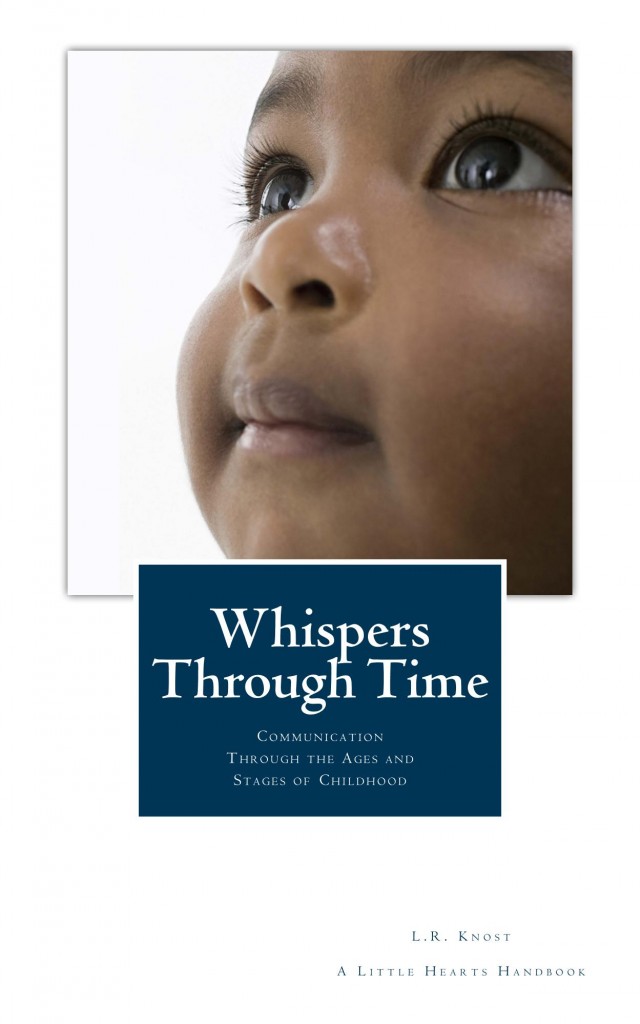
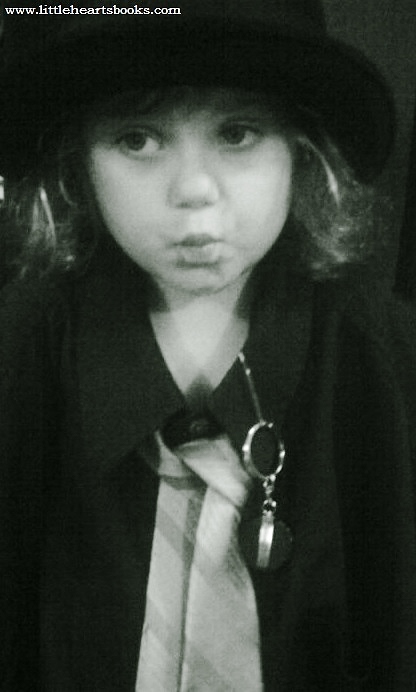 [Reprinted from
[Reprinted from 